Market Research Panel Definition: All You Need to Know for Meaningful Market Research
Market Research Panel Definition: All You Need to Know for Meaningful Market Research

Have you ever considered using a market research panel to lead your research campaigns? This method is typically applied to market research, which is essential to understanding and satisfying your customers.
Market research is critical for all businesses, no matter how attuned you may consider yourself to be with your customers. The importance of market research cannot be understated; it helps you keep continuous tabs on your most important customers: your target market.
There are many routes you can take in the broad field of market research, as there are many market research techniques available. This includes primary and secondary methods of obtaining the research.
A market research panel is one such technique. This research method grants researchers participants who opt into a study, typically one that is conducted through multiple rounds of research, whether it is through surveys or other tools.
The panelists that make up the research panel are not randomly selected; instead, they are recruited and pre-screened.
Panels have various nuances that you ought to know about before selecting a research method, especially one that concerns how you’ll reach your target market. You should also compare panels with organic sampling, which is a different approach to identifying and gathering respondents for your research studies.
Luckily, this exhaustive guide allows you to do just that.
This guide explores the market research panel in full depth, delving into why it matters, how it is put together, their different types and much more. In addition, this article covers their drawbacks and how organic sampling is the better research method.
Table of Contents: How To Conduct A Survey That You Can Trust In 8 Steps
- Defining the Market Research Panel
- Market Research Panels: Why Do They Matter?
- How to Put Together Market Research Panels?
- The Need to First Identify Your Segmented Target Audience
- Market Research Providers and In-House Research Teams
- Determine your panel size
- Using Online Channels to Opt-In Potential Panelists
- Vetting Your Panelists
- Incentivize Your Panelists
- Carry Out Panel Research
- Maintain and Manage Your Survey Panel
- Are There Different Types of Market Research Panels?
- What Are the Advantages of Using a Market Research Panel?
- How Does an Online Market Research Panel Benefit Brands?
- Are There Drawbacks to Using an Online Market Research Panel?
- Combat Reduced Research Quality Using Organic Probability Sampling
- The Need for a Strong Market Research Platform to Leverage Organic Sampling and More
Defining the Market Research Panel
A market research panel can be defined as a selection of research participants, chosen specifically for market research purposes. But there’s much more to this.
A market research panel is a pre-recruited group of people who have agreed to take part in market research studies. These studies can be conducted through a variety of methods and tools.
The research tools and methods used with panels can include the following:
- Online surveys
- In-depth interviews (IDIs)
- Focus groups
- In-home use tests (IHUTs)
- Mobile ethnographies
- This involves studying customers in a natural environment but with the addition of technology to document and analyze real-time customer experiences.
- For example, it may use mobile ethnography app systems to conduct these studies. This allows you to remotely research human behaviors, journeys and experiences.
- Field research
Those selected to partake in a market research panel are usually used in more than just one research survey, even if they only enlist in one survey campaign. That means they can be expected to partake in several rounds of interviews, surveys, focus groups, etc.
This is why researchers who typically opt to reach participants via a research panel use the panelists to conduct longitudinal research. Longitudinal studies involve repeatedly examining the same individuals to detect any changes that might occur over a certain period.
Longitudinal studies are a kind of correlational research; researchers gather and observe data on a variety of variables without influencing the variables in any way.
This kind of research uses longitudinal surveys and can last years.
Despite being associated with the research of change and development, a market research panel can also be used in cross-sectional research. These kinds of studies deal with collecting research about a particular population at one fixed point in time. Due to the nature of this research, it is often referred to as a snapshot of a target population.
You can use a panel for this kind of research by using cross-sectional surveys.
A market research panel helps researchers better understand the strengths and weaknesses of – or sentiments towards – a particular product, service, brand, or message. Because researchers are often fact-finding on behalf of brands, these panels also can be known as brand research panels.
Market Research Panels: Why Do They Matter?
Market research panels matter for a variety of reasons.
First off, they provide both researchers and businesses who have no dedicated research personnel, with a go-to set of participants they can study firsthand continuously. This is critical, given that a major aspect of research is to target the correct audience in your study.
In market research, studying your target market is an absolute necessity. Panels provide easy and constant access to a target market sample, the pool of participants who represent your target market.
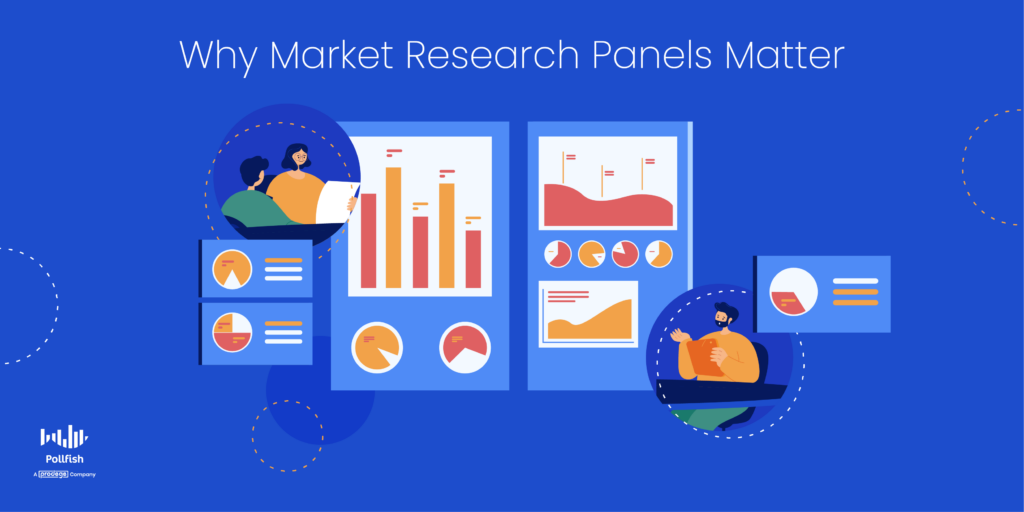
As such, the panelists are the research subjects, which is the crux of any research (unless you’re not studying humans). They are key to market research, as this research type is centered on understanding your customers to test the viability of any new product or service, and most importantly, sell to them.
Thus, the market research panel provides researchers et al. with a reliable group of research participants that they can turn to continuously.
This is a major convenience, given that it means researchers won’t have to scramble for research participants each time they need to conduct a research campaign. They also can rest assured that they’ll have research subjects to use in any ongoing research project, such as in longitudinal or prospective studies.
Aside from long-term research, panels can also be used in the aforementioned cross-sectional research studies as well.
In addition, panels provide businesses with a method to be more noticeable to their customers in an oversaturated market. Against the backdrop of social media and second screening, product owners, service providers and marketers are fighting tooth and nail to stand out in an increasingly crowded marketplace.
While some are becoming harder to differentiate, since many brands compete on similar price points and features, there is still one area up for grabs: a customer’s experience.
Thus, by designing a pleasant research experience and mentioning your business in the study, customers will associate their good memories during their research experience with your business.
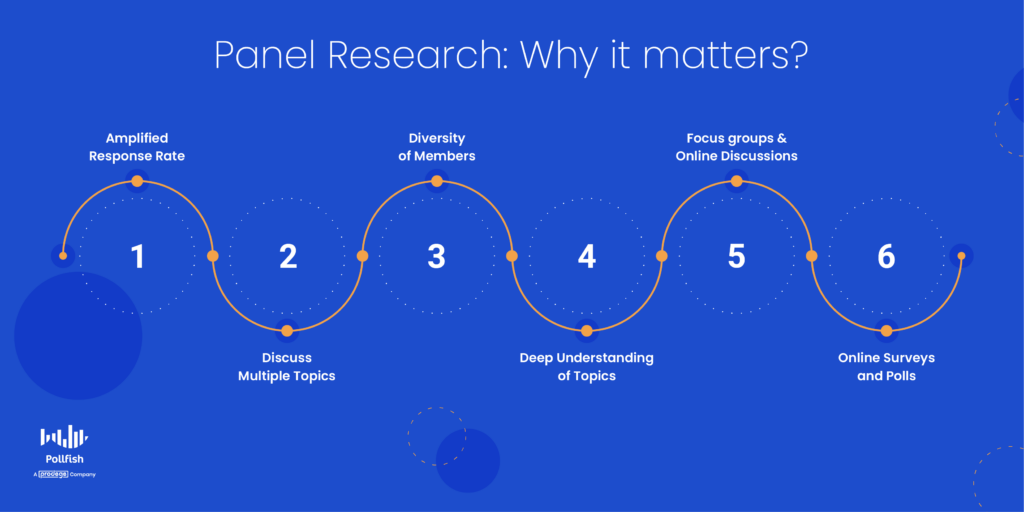
In this scenario, the study itself serves as a marketing tactic to make your business resonate with its target market.
All in all, market research panels ensure you have constant access to your target market for your research study. They get to the heart of the matter of your area of study. The goal is to actively listen to and act upon the insights gleaned from your panelists.
Once you understand how your product or service makes your research panel feel, you can make the necessary changes to position your brand more effectively — irrespective of price or feature set.
How to Put Together Market Research Panels?
Today, market research panels are usually recruited via digital channels, as opposed to in-person scouting and interviewing. The latter is still possible, but not very common, given the ease, speed and prevalence of the Internet.
The following sections explain how to form, recruit and manage market research panels.
1. The Need to First Identify Your Segmented Target Audience
It’s important to ensure that you identify the target market segments you’ll need to include in your study before you recruit your panel. As such, we recommend conducting market segmentation first.
This way, you’ll know the distinct segments that make up your broader target market. In addition, performing segmentation allows you to identify your customer personas. These are fictional characters that represent unique members of your target market who fall under specific demographics, psychographics and the like.

You can conduct market segmentation with the help of market research software, particularly survey software. This will allow you to conduct surveys on any topic, including narrowing down your target market into segments.
Once you’ve segmented your target market and created various customer profiles, it is time to move on to determining the correct target audience.
Your survey target audience and your panel target audience specifically need to be determined before you recruit your panelists.
Your target market is not the same as your target panel audience
Keep in mind that neither your target market nor its segments are equivalent to the target audience of your panel. This is because a panel, like other research techniques, is centered on different topics.
Each topic may require different audiences.
You may have a survey campaign that relies on studying one market segment, or a few. Additionally, you may need to conduct another research campaign on another topic, one that involves different segments and customer personas.
Although you’ll be choosing from the same market segments, each segment will not satisfy or be appropriate for every panel study you conduct. Thus, your panel audience is separate from your market segments.
This is crucial and must be done before you reach out to your potential panelists.
2. Market Research Providers and In-House Research Teams
Once you’ve determined the panel audience you’ll need for your market research studies, you’ll then need to choose from one of two main options to put together your panel.

The first main option is to use market research panel providers that you have discovered and trust. Typically, this is done via the Internet. The panel provider would recruit and opt-in the panelists.
However, you and your team would still be involved in the process of targeting the panelists, as you would need to share your target market segments with the panel provider. Most importantly, you would need to inform them of your target panel audience.
As discussed in the previous section, these are not the same populations.
Alternatively, some businesses with in-house research teams find their panelists by releasing their ads and notices online. This is the second main option for creating a market research panel. You would need to enlist the panelists via your online platform of choice.
There are many options available for obtaining panelists in the digital space.
3. Determine your panel size
Before you recruit your panel, you’ll need to determine how many panelists you’ll need to participate in your research panel. To do so, you need to consider the following factors:
- Your ideal sample size,
- Your response rate
- The number of studies you intend to execute
For example, imagine you need 700 responses per survey; you have a response rate of 40%, and you’re seeking to run two studies each month. You’ll need to plug each variable into the following formula to find your panel size.
The panel size formula is:
(sample size per survey / (response rate) x (studies per month) ) x 100 = amount of panelists needed
(500 / 40% X 2 ) x 100 = 2500 panelists
Bear in mind that some people will not want to remain for the entirety of the study and will thereby leave. This is known as panel attrition. As a safety net for attrition, make sure to form a panel that consists of 10-20% more panelists than what the formula calculates as your ideal panel size.
Make sure you have all the requirements in hand before you start recruiting and aim to go 10-20% above your minimum number to cover you in case people opt out of your panel or you don’t hit your target response rate.
4. Using Online Channels to Opt-In Potential Panelists
There are a variety of online channels that you can choose from to obtain and opt-in your potential panelists.
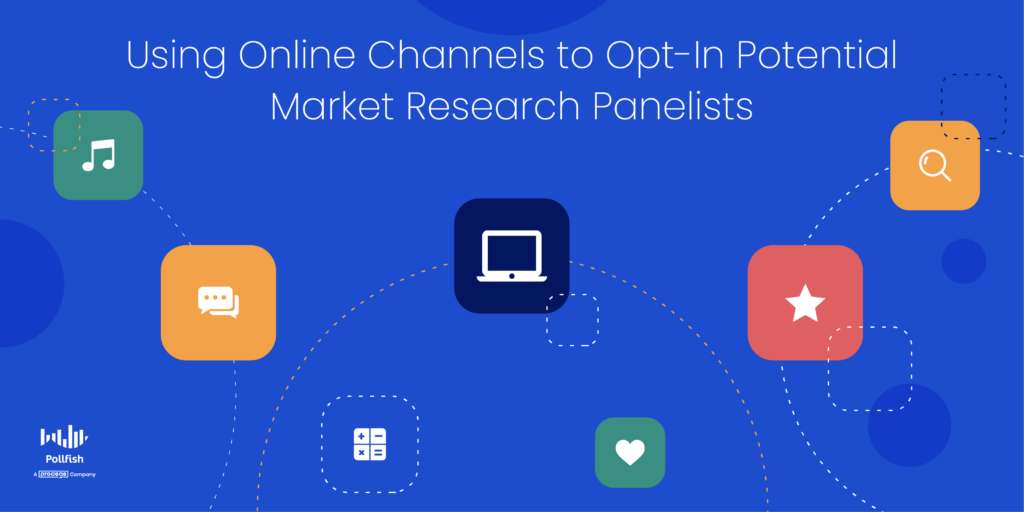
You can invite participants to join your panel through web ads, email lists, social media, website landing pages, homepages, or third-party app partners.
They would then be asked to opt in and complete an onboarding questionnaire, which helps to organize them based on certain distinguishable traits. such as age, gender, location, profession, and personal interests.
These can be — and oftentimes are — based on the potential panelists’ demographics, psychographics, behaviors and geographical locations.
5. Vetting Your Panelists
The questionnaire you use should vet your potential panelists on a wide range of traits and their subcategories. You wouldn’t want to enroll the wrong audience in your panel. In addition, you would want your panelists to align with all the requirements you determined for your panel audience in one of the previous sections.
As such, you should vet your potential panelists, those who opted in through any of the online channels you chose, with a rigorous set of panel criteria.

The following explains the criteria for choosing the correct research panel:
- Demographics
- This involves basic groupings based on the potential panelists’ gender, age, income levels, race, ethnicity, employment type, education, salary, etc.
- You can get as granular as you wish, provided you have the right tools to do so.
- Psychographics
- This involves the attitudes, interests, lifestyles, aspirations, values and other psychological criteria you would need to group your panelists by.
- It also involves whether they engage in particular customer behavior, such as frequency of purchases, brand preferences, consumer loyalty to certain brands, etc.
- Geographical locations
- This can include macro and micro-locations.
- As such, you may need to target panelists based on their country, state, territory, city, zip code and more.
- The granularity of targeting will depend on the kind of methods your panel provider or your in-house researcher team uses.
- Firmographics
- This category applies when you seek to form a panel of business personnel, which you will need for conducting B2B research.
- As such, it requires running B2B surveys.
- Assure that the company you aim to use panelists from matches the needs of your study.
- Demographics
6. Incentivize Your Panelists
Participation in a research panel is often incentivized. Few people would devote their time and efforts for free, not least for a continuous project, which most panels often are used for.
As such, remember to offer panel members rewards in exchange for their feedback and time. You’ll need to consult with your panel provider if you don’t recruit and work with your panelists yourself and are concerned about incentivizing them.
These rewards can vary from one vendor to the next but can be monetary or non-monetary. Thus, they can include cash, gift cards, vouchers, free subscriptions to a service and free products. You can also offer a points system in which panelists can redeem for goods and services.
7. Carry Out Panel Research
Now that you have formed a market research panel, it is time to use it for your various research purposes. You’ll want to first split your panelists into different market research campaigns and studies. As mentioned earlier, each panel study will require a different audience.
Therefore, before you begin conducting your research with your panel, make sure to assign it to its designated research campaign, its sub-campaign and its particular study. Once you do this, you can conduct your studies.
To reiterate, once you have put together your panel, you can choose from various research tools and methods. You can opt for surveys, focus groups, phone interviews, mobile ethnography, in-home use tests and more.
During your research sessions, make sure you record as much information from the panelists as possible. This is why using surveys is an ideal route, as they collect all the insights your panelists share, as opposed to experiments, product testing and focus groups.
8. Maintain and Manage Your Survey Panel
Managing your survey panel is not the same as recruiting it. It takes practice and best practices to ensure you maintain your panelists and build a strong relationship with them. They are people, after all, and not solely those who take your survey once.
As such, you should attempt to form strong connections with your panel. Whenever you reach out to them, whether it's over email or phone, be friendly and use language that makes your panelists feel important and appreciated.
Avoid sounding too generic and make your outreach personable — and personalized. Ask yourself, before you send any emails, if you would open the email, read it in its entirety and respond.
It’s crucial to ensure your research is easy to partake in, yet another reason to distribute surveys, as they take less time than field research, experiments and the like.
If you’re managing a panel in-house, you should consider assigning a designated person to manage the panel. Use someone from your business to keep in touch with the panel members and serve as the head of the panel.
Always keep your research promises to avoid panel attrition. This means, that if you’ve set a specific cadence of 1 study a month or 3 interviews per month, make sure to honor that cadence. Going above or below it will frustrate your panelists and make you untrustworthy.
It will therefore cause chaos in your study, which can easily lead to attention.
Are There Different Types of Market Research Panels?
Market research panels can be split into two main groups: B2B panels and B2C panels. There are many other subgroups within each category, but it is key to know their presence and differentiating qualities.
- B2B (business-to-business) panels are made up of business owners, professionals, industry experts, advisors and decision-makers.
- Panelists often respond to business-related surveys regarding industry type, segmentation, or market demographics.
- This kind of panel would require vetting members based on firmographics.
- B2C (business-to-consumer) panels comprise customers or end-users of a brand, product, or service.
- Businesses use these panels to access feedback from their target audiences.
What Are the Advantages of Using a Market Research Panel?
Online market research panels tend to be more popular than other, more traditional research methods. Often called legacy research methods, they usually take more time and effort to complete and don’t provide the same precision as a smart online survey platform does.
Take telephone interviews, for example. These require a lot of time and expense to run, and there’s no guarantee that the person answering the phone is 1) interested and available to speak, and 2) fits within the target demographic you wish to hear from.
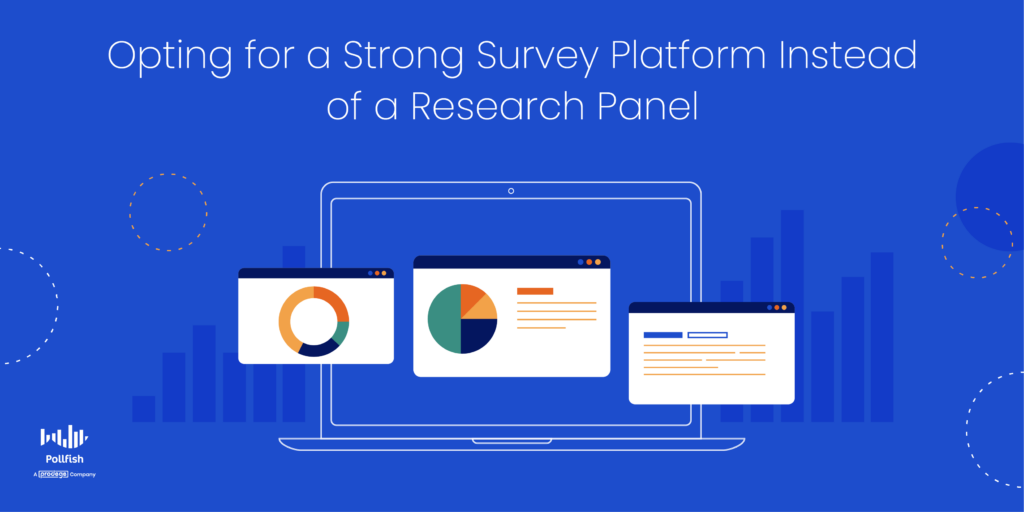
Research panels, on the other hand, are made up of pre-screened individuals who have already opted-in to respond to surveys. This makes panels more cost-effective (and faster) to run.
Other advantages of market research panels include:
- Higher response rates: Respondents are motivated to take part in research and are less likely to be “caught cold” by a survey. This is usually because they’ve signed up themselves via an app or website, have subject matter knowledge they wish to share, or are incentivized by rewards, such as cash, vouchers, or points.
- Diverse viewpoints: A well-run, established research panel can be made up of any number of individuals from different backgrounds, professions, age groups, or locations. This level of variety allows you to mirror your specific audience during a research project.
- Reliable panel screening: The onboarding process of a panelist means their demographics are captured and categorized from the outset. This makes market segmentation easier and allows research panels to be convened quickly to gauge opinion or test the waters with a new product or service.

How Does an Online Market Research Panel Benefit Brands?
In addition to the advantages mentioned above, research panels have specific benefits for the brands and businesses that utilize them:
- It offers quicker research turnaround: If a brand has entered the final stretch of a product development initiative or marketing campaign, and wishes to check in with their target audience, pulling together a focus group at the last minute can be challenging – and expensive. Market research panels let brands access insights and feedback faster than other research methods.
- Multimedia elements can be included: Online market research panels can seamlessly include video, photographs, and sound clips to enrich the survey experience and provide a far better level of feedback. Using multimedia elements in other forms of market research can range from difficult to impossible.
- Products/services can be tested with real end-users: Before releasing products or launching services to the wider market, brands can test them with a facsimile of their target audience. Panels allow brands to gather actionable insights quickly, gauging sentiment and performance in the process.
Are There Drawbacks to Using an Online Market Research Panel?
While market research panels do benefit both analysts and brands alike, they’re not immune from some glaring pitfalls. You should be aware of them before selecting this method for conducting research.
- Limited to those with internet access: As the name suggests, an online market research panel requires internet access. This is fine if your target audience is from a country where the internet is easily affordable and accessible, but if you wish to learn more from an older and/or remote group of people, it’s perhaps not the best research method.
- Risk of duplicate respondents: People who enjoy participating in surveys (or are motivated to do so via incentives) will likely sign up for multiple survey vendors. This can result in the duplication of responses, skewing the data in the process. While some vendors will do their best to remove duplicate respondents, it’s still important that the data is scrutinized.
- Risk of poor data quality: Speaking of data, surveys can attract a range of less desirable respondents, motivated solely by incentives and with no interest in sharing considered opinions and feedback. Speeders, straight-liners, survey professionals, fake accounts, bots, and more, these types of panelists can quickly derail a survey.
- Acquiescence bias and other biases: Also called agreement bias, acquiescence bias occurs when panelists are inclined to provide only positive or agreeable answers. With this bias, respondents feel more social pressure to answer in a particular way, as their identities are known to your business or the panel provider.
- Longer recruitment and vetting periods: It doesn’t take a few minutes to vet and recruit a panel. That’s because you would first need to target its members, have them opt-in, review their self-identifying questionnaires to confirm their qualifications and ensure you have the required panel size before you even form the panel, let alone conduct the research with it.
Combat Reduced Research Quality Using Organic Probability Sampling
Although research panels can deliver a range of benefits, the market research panel definition we shared at the start of this article only tells part of the story.
While these panels are largely comprised of motivated research participants — survey participation has been on the wane. This means the quality of research panels is fast becoming compromised as traditional companies scramble for participants from anywhere and everywhere.
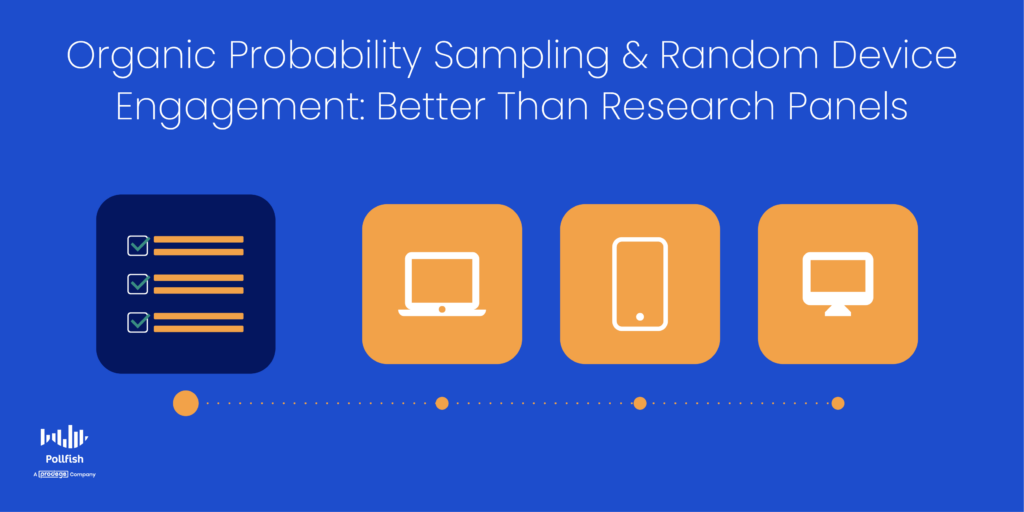
At Pollfish, we avoid using conventional panels for this very reason. Instead, we’ve developed our very own market research methodology called Organic Probability Sampling. This involves sourcing our audience of real consumers via partnerships with app publishers, which allows us to conduct randomized, yet highly targeted surveys to verified respondents.
Our unique process is known as Random Device Engagement, (RDE), which uses the organic sampling approach for finding and obtaining survey participants.
This randomized method of reaching respondents ensures you avoid acquiescence bias from respondents, due to the anonymous nature of this route.
In addition, it allows you to steer clear of the sampling bias, which occurs when the respondent selection process is not conducted at random, which then leads to under or overrepresentation of a certain market segment.
A kind of organic probability sampling, RDE polling relies on advertising networks and other digital platforms to engage potential respondents wherever they visit voluntarily. This includes a variety of digital platforms and properties, such as:
- Mobile sites
- Apps
- Website
- Mobile games
With over 250 people in our network, we never have to worry about data quality, delivering only the best, most authentic, and most useful insights to our clients.
The Need for a Strong Market Research Platform to Leverage Organic Sampling and More
Our final word involves highlighting not merely the importance of organic sampling and RDE, but the need to leverage the right online survey platform to carry out your entire research campaign.
A potent online survey provider, one that offers enterprise survey software will do all the heavy lifting for your market research campaigns. That’s because such a platform doesn’t simply facilitate creating surveys.
Instead, it allows you to hyper-target your survey audience, set quotes, reach populations from far and wide and ensure your survey gathers the exact amount of respondents as you input into your audience requirements section.
It would enable you to target respondents based on screening questions, along with inputting a large swath of respondent qualifications, including the four main categories of demographic, psychographic, geographic and firmographic identifiers.
In addition, a strong survey provider grants you options aside from the Random Device Engemanet method of reaching respondents. Instead, it should also afford you the option to survey specific people, via the channels you specifically choose to deploy your surveys through.
This includes using channels such as via email, or whichever digital channel you seek to use. Fortunately, we offer the Distribution Link feature, which allows you to do just that.
All in all, a strong survey platform that offers random sampling through RDE and a variety of market research features and tools trumps market research panels.
Luckily, the Pollfish platform uses the RDE method and offers a variety of market research features such as A/B testing, conjoint analysis and much more to ensure a quality research campaign and avoid survey biases and fraud.
A market research panel is a group of individuals who have been recruited to take part in market research, which may include surveys, online panels, or in-person panels. B2B (business-to-business) panels focus on the relationship between two businesses and may consist of business owners, industry experts, and other professionals. B2C (business-to-consumer) panels focus on the relationship between the business and their target market (the consumer). B2C panels will consist of members who represent that target market. Online market research panels are more popular than their traditional counterparts for several reasons. Online market research panels are most cost-effective, faster to deploy, have higher response rates, provide better data sampling, and allow for diverse viewpoints to be heard. Online surveys can attract individuals who participate in surveys solely for the incentive or reward. These respondents are less motivated to share genuine opinions. There is also the risk that fake accounts and bots could be used to game the system. The results gathered through online market research panels can be improved by using organic probably sampling, a market research methodology developed by Pollfish. This approach sources survey respondents who are motivated to participate for genuine reasons.Frequently asked questions
What is a market research panel?
How do B2B market research panels differ from B2C panels?
What are the advantages of an online market research panel?
Why is poor data quality a risk of online market research panels?
How can you improve data quality of online market research panels?
How To Conduct A Survey That You Can Trust In 8 Steps
How To Conduct A Survey That You Can Trust In 8 Steps
So you want to conduct a survey, not any run-of-the-mill survey, but one that you can trust, that is, one that quickly gathers the total number of survey respondents you selected — with the correct demographic and psychographic traits.
To do so, you’ll need to be able to preset these requirements in an online survey platform.
You’ll first need to find a potent online survey platform, along with understanding how to conduct a survey that provides accurate and reliable data on your target market.
While building a strong survey campaign can appear to be difficult, if not downright intimidating, it is much simpler than it looks. This simplicity will depend on the survey platform you choose, as they are not all the same.
Nonetheless, there’s a process to conduct a survey that you can use across multiple campaigns, whether you need to conduct local or global surveys, study customer behavior, or even increase your customer retention rate.
Luckily, we’ve prepared an easy-to-follow, 8-step process for conducting surveys. This article is an 8-step guide to help you to design, conduct, and organize an effective survey in no time. Let’s dive in.
Table of Contents: How To Conduct A Survey That You Can Trust In 8 Steps
- The Importance of Conducting Surveys
- What You Need to Conduct a Survey
- Steps to Conduct a Survey
- Step 1: Identify Your Research Goal
- Step 2: Define Your Survey Audience
- Step 3: Come up with Preliminary Questions
- Step 4: Design Your Questionnaire
- Step 5: Distribute Your Survey
- Step 6: Organize Survey Responses
- Step 7. Analyze and Present Survey Results
- Step 8: Take Action
- Making Every Survey Count
The Importance of Conducting Surveys
First off, let’s uncover why you should conduct a survey in the first place. After all, there are a variety of other market research techniques you can use, including both primary and secondary research methods.
One of the most important reasons to conduct survey research is due to the prowess of surveys; they grant you original hard data and facts. You can use surveys to study virtually any subject and gain both quantitative and qualitative insights.
Data, especially customer data, is becoming more and more sought after, as 40% of organizations aim to increase data-driven marketing budgets, and 64% of marketing leaders believe that data-driven strategies are vital in today’s economy. Surveys act as a convenient conduit to gain access to any sort of data, whether it is consumer-related or otherwise.
Conducting surveys on your customers is one of the most effective ways to collect invaluable data and gain answers to concerns that are important to you. This is core to market research, as it allows you to better understand those most likely to buy from you, aka, your target market.
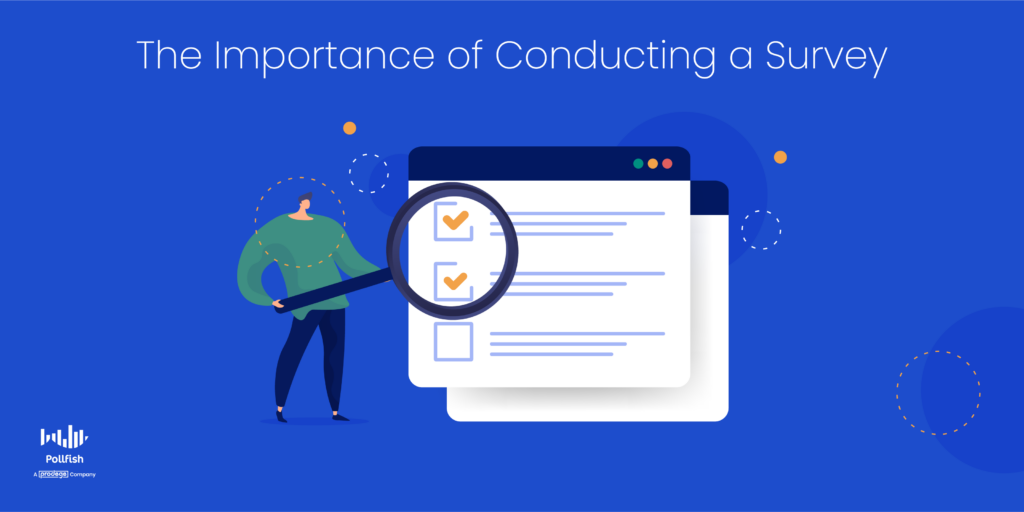
So how can you use surveys as a means of data for decision-making? There are numerous campaigns and insights that surveys can avail and unlock.
Surveys let you uncover hidden growth opportunities, reveal public sentiment, gain deep insights into customer buying behavior, and even get extra media coverage when prominent publications cite the findings of your research.
They also prevent you from making the wrong business decisions, whether it deals with releasing a new product, creating an ad campaign that won’t resonate, appealing to the wrong persona and much more. Thus, surveys allow you to discover your risks, decide on whether they are worth taking and avoid mistakes.
As an added bonus, simply the act of conducting a survey affects customer behavior, along with their opinions of a company. Specifically, the satisfaction of writing a positive survey response creates a desire to buy more of a product. With this information in tow, brands that include their name and likeness can increase sales simply by conducting a survey.
As such, surveys don’t merely provide you with an understanding of your customers’ needs, wants and sentiments; they also allow you to affect their perception of your brand and their willingness to buy from you.
In this way, and as mentioned in the above link, surveys, especially those that provide positive experiences, contribute to your revenue, which keeps your business afloat. Aside from granting you new customers, you can also use them to survey existing customers.
By offering them a good experience and presenting your company in the best possible light, surveys also help you boost consumer loyalty, which is an absolute must. Loyalty is the core of customer retention, which is often cited as more important than customer acquisition.
For example, did you know that 80% of profits come from just 20% of your existing customers? In addition, retaining customers is far less costly than acquiring new ones. There are plenty of statistics that back up the claim that customer retention is both more profitable and less expensive to achieve than customer acquisition.
For example, consider the following:
- Increasing customer retention by just 5% can increase profits from 25-95%.
- The success rate of selling to an existing customer is between 60-70%, while the success rate of selling to a new customer is only 5-20%.
All in all, conducting a survey is crucial to the well-being of your customers and your business. Surveys help you unearth virtually any insights which you can then use to guide your next or ongoing business move.
What You Need to Conduct a Survey
If you want to get meaningful results that you can act on, there are certain things you’ll need to have and certain actions you’ll need to take. These will steer your survey campaign in the right direction, give you the most accurate and useful results and ward off survey bias.
Before we dive into the steps to conduct a survey, let’s glance over the things you’ll need (not all of which are tangible), to conduct your survey. These are a must and must be present within the online survey platform (or market research agency) that you use.
The following list lays out everything you need to conduct a successful survey:
- Survey the correct population,
- Use the correct survey distribution method (see Step 5)
- Make sure your survey provides a pleasant survey experience
- This includes ALL digital properties where your survey will live, such as websites, mobile sites, apps and more.
- Have the ability to customize your surveys to your liking
- Have various questionnaire building options, such as
- Survey templates
- Advanced skip logic
- Different screening options for demographic and psychographic screening
- A filtering system
- Screening questions
- A wide variety of question types you can use, such as
- Matrix questions
- Open-ending questions
- Likert scale questions
- Rating scale questions
- Be able to create a variety of specialized surveys, such as
- The Net Promoter Score (NPS) survey

- The Customer Satisfaction Score Survey, aka, CSAT survey
- The CET (Customer Effort Score survey)
- Visual rating surveys, which include
- ones that use hearts,
- stars
- emojis
- other visual ratings as scaled questions).
- Both B2C and B2B surveys
- The Net Promoter Score (NPS) survey
- Access to granular insights via a post-survey results dashboard and a survey builder.
- Use a platform that offers 24-hour technical support
- Can conduct global market research
- Leverage a system that offers a wealth of technical and quality checks to avoid survey fraud
- This helps you avoid
- Gibberish answers
- Respondents who aren’t paying attention
- Flatliners (those who keep answering with the same choice in multiple-choice questions)
- Bots
- Those hiding their location via VPN
- This helps you avoid
As you can gather, there are various elements to a successful survey. You’ll need to therefore carefully select your market research platform — or agency, if you’re taking the syndicated research path.
You don’t want to settle for a low-tier platform, otherwise, you risk collecting unneeded biases and a whole host of low-quality data.
Steps to Conduct a Survey

Follow along the 8 steps in this guide to conduct meaningful survey research.
- Step 1: Identify your research goals
- Step 2: Define your target audience
- Step 3: Come up with preliminary questions
- Step 4: Design your questionnaire
- Step 5: Distribute your survey
- Step 6: Organize survey responses
- Step 7: Analyze and present survey results
- Step 8: Take action
Step 1: Identify Your Research Goal
Every successful survey has a purpose. You’ll need to identify yours to get started. This will serve as the basis of the entire survey campaign.
In order to identify your research goal, you’ll need to consider the insights your business needs most. Consider the following questions to ask yourself and your team:
- Do you need to steer an advertising campaign?
- Do you need to form a marketing strategy?
- Are you trying to find out why you are losing customers?
- Do you want to know if your policies are effective?
- Are you figuring out what to do in the current market?
- Do you need to discover your own employees’ sentiment about your workplace?
- Would you like to cut back your customer attrition rate?
The kinds of questions you need to ask yourself and your company’s different departments are limitless.
We suggest forming a survey that relates to your most pressing needs, or setting up a proactive survey study, that is, a survey campaign designed before you go through with something, such as designing a new feature or ad.
Understanding your survey’s main goal both improves its quality and reduces the time you’ll spend on executing your research.
In case you struggle to pinpoint your exact goal, write down a list of all the questions and issues your market research campaign needs and prioritize the most important ones.
In addition, ask yourself and your team questions to better understand your own standing in regards to market research, your existing tools, campaigns and more. These are your peripheral questions, which will help you determine your key research goal.
The following questions will help you understand your survey goal better:
- Do you understand who comprises your target market?
- Do you need to segment your target market further?
- Do you already have any existing data that you can use?
- Do you need data to improve an existing product or launch another?
- What resources do you have to perform the survey?
- What actions are you going to take after the survey is complete?
After you have figured out the main goal of your research, you will need to define your survey audience.
Step 2: Define Your Survey Audience
Identifying your survey target audience is key to any successful market research campaign. After all, it is the audience that you seek to study, to learn how its members tick, their habits, sentiments, etc.
The wrong survey audience will invalidate your study, as it will be irrelevant to your business or study.
There are two main concerns when it comes to surveying participants: who should I survey and how many participants do I need?
Let’s clarify both.
Who should I survey and who is in my target market?
Surveying the right people makes all the difference. That’s why before determining your survey audience, you’ll need to first identify the makeup of your target market. To do so, you’ll need to conduct secondary research, along with consolidating what you already know about your target market.
In addition, you’ll need to conduct market segmentation, which will allow you to break your wider target market into various segments. These can exist on the basis of various factors, such as age, ethnicity and other demographic factors, along with behavioral aspects, such as buying habits, frequency of purchase, brand trust and more.
You can do this by conducting an RFM analysis, which is an abbreviation of Recency, Frequency and Monetary Value. In this analysis, researchers estimate the value of a customer based on the three data points in its abbreviated title. This is one of the models for customer behavior segmentation.
Targeting a specific audience is important for many reasons. For example, suppose you want to learn if iPhone users are happy with the recent product updates.
By surveying random iPhone users, you may notice that the majority of responses are somewhat neutral. But if you target specifically the Gen Z generation, you might learn that the younger demographic is worried about having to buy extra accessories.
The more defined your target audience criteria are, the more accurate and deep your survey insights will be. Thus, make sure to brainstorm, segment and fully identify your target market and your own customer personas before setting up your survey questionnaire.
Identifying them first will show you which target audience you’ll need for your survey to gain the most accurate insights and help you fulfill your survey goal.
How many survey respondents do I need?
When doctors want to examine your blood, they don’t drain all of it - they just need to take a small sample. The same principle stands with surveys: a small sample of survey respondents can accurately represent the opinions of a larger group.
For example, if there are 5,000 people in your company and you want to know how well the latest HR policy was received, you don’t need to survey all 5,000. In fact, surveying just 146 employees will be enough.
Thus, if you want to learn what all American high schoolers think about the recent TikTok ban, you don’t need to ask all 76 million of them. Surveying between 200 and 600 respondents will give you a sufficient amount of opinions to draw from.
For the majority of studies, 200 to 800 respondents will be enough to represent the thoughts and opinions of a particular population. However, all studies are not built the same, nor are they geared towards the same kind of longevity, think longitudinal surveys versus cross-sectional surveys.
As such, you’ll need to calculate your survey sampling size, which is also referred to as a sampling pool.
If you want to calculate how many respondents you’ll need to get scientifically accurate survey results, feel free to use our sample size calculator.
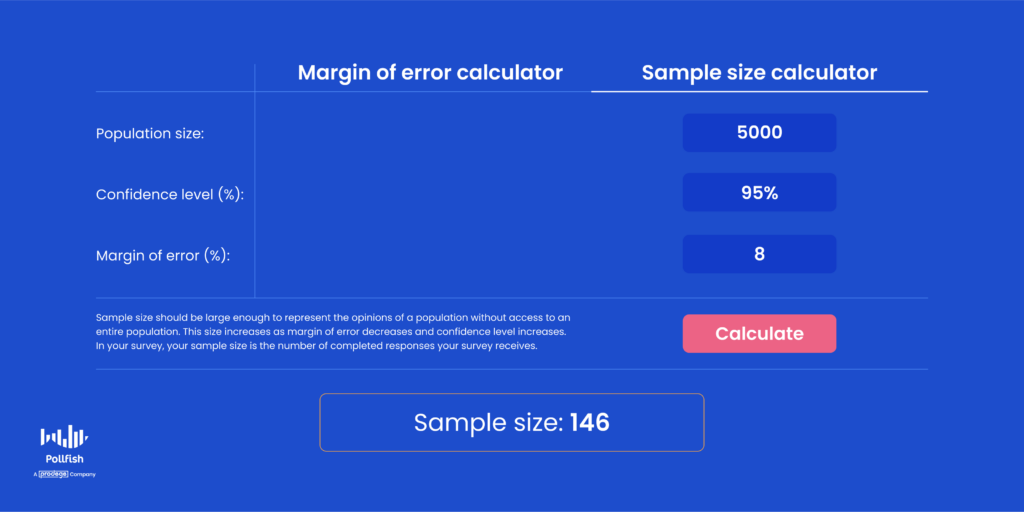
Step 3: Come up with Preliminary Questions
Now that you’ve carefully selected a main survey goal and theme, along with having identified who to survey and how many to include in your sampling size, it is time to get to the heart of your survey: the questionnaire — or at least the beginning of it.
To do this, you’ll need to consider the main goal and subgoals of your survey campaign. As such, write down the most pressing questions you have. We suggest coming up with a list of 10 questions.
Note that not ALL of them need to be in your survey, in fact, we suggest keeping your questionnaire short. Even users of a game who’ve come across your survey and decided to take it for in-game survey incentives will hesitate to take a lengthy survey.
As such, your preliminary 10 (or more) questions are just that: preliminary. Not all of them will make it to your questionnaire, as they are meant for brainstorming ideas.
As you create these questions, heed the following tips:
- Create questions based on the survey campaign you’re going to use.
- For example, if you’re going to run a longitudinal study, you’ll need to create questions that span through various time periods.
- Or, for a cross-sectional study, you’ll need to create questions for just one survey and thus have one primary focus of the study.
- Do any of your questions appear too similar to one another? If so, consider merging them or removing a few.
- Decide whether certain questions need follow-up questions.
- For example, if you ask a question in which a certain answer requires more information, consider using follow-up questions.
- That’s where advanced skip logic becomes handy, as it routes respondents to relevant follow-up questions.
- This creates paths in your survey and allows you to understand your respondents and the subject of the original question at a deeper level.
- This can also be relevant to the first point, as you can use similar questions as potential follow-up questions.
- Do your questions pertain to certain customer segments or personas?
- If so, refer to your customer segmentation and personas list. You may need to break your survey into two or more, depending on how many customer segments it can be used for.
- You can also add multiple audiences in one survey.
- Show your preliminary set of questions to your team/colleagues for their feedback and suggestions.
- Here, you can get into the nitty-gritty of what is most important for your study by way of other relevant opinions that will help shape it.
Step 4: Design Your Questionnaire
Next, we’re going to move on to designing the questionnaire itself. This will largely depend on the survey platform you use. As aforementioned, you’ll need to use a strong market research SaaS platform that offers a variety of features and services to form a robust survey campaign.

Make sure your survey platform allows you to build the questions you need at ease and speed.
It’s key to note that the quality of a questionnaire is where the majority of surveys fall short. Experiments suggest that sensitive or vague opinion questions increase the potential of error by up to 30%. Put simply, your survey is as good as your questionnaire is.
Make sure your questions are clear and don’t contain jargon or uncommon abbreviations. This is key to shaping the survey experience.
A poor example of a survey question: Do you think VR is going to take off in the next 5 years?
A better example of a survey question: Do you think virtual reality (VR) is going to take off in the next 5 years?
In some instances, a poor question is one that yields scant information. In this case, it is key to follow it up with another, or create it so that it doesn’t require additional questions to begin with. In this case, a yes or no question constitutes a poor example, whereas an open-ended question is the better example.
A poor example: Do you agree that this is a great movie?
A better example: What do you think of this movie?
Take some time to learn how to write clear, unbiased, and effective survey questions to get the best results out of your research.
Step 5: Distribute Your Survey
There are several ways to distribute a survey. These include legacy distribution methods and modern ones. While it may not appear to be very important, choosing how your survey is distributed is as important as choosing who you want to survey.
This is because survey distribution accounts for many aspects of your study, including the following:
- Where your survey will exist
- In the digital vs analog world
- On websites or apps
- Used as part of a focus group
- If your target market see your survey based on its distribution channel(s)
- When your target market will see your survey
- How quickly you’ll gain respondents and completed surveys
- When you can access your post-survey dashboard
- When you can carry out a survey data analysis
- Associations of your brand (if you mention it in the survey)
- How long it takes to complete your survey
- For example, an online survey platform that continues iterating until it receives all required responses works faster than do interviews that a market research firm conducts.
The environment of the survey is critical to its exposure by your target market, as Point 2 states. This is because different demographics spend time online (and in the real world) differently.
Let’s continue with the example of surveying Gen Z iPhone users. Suppose you moderate a local school Facebook group and decide to post your survey there. Even if you get a large number of responses, the results may not accurately affect this demographic.
This is because in this case, you don't pick survey participants randomly, instead, you survey only those who joined the local school Facebook group that you conveniently happen to moderate.
This is called convenience sampling, since the majority of survey participants unintentionally live in one area. The survey didn’t account for Gen Z users from other areas with different average household incomes.
To ensure you get the most accurate survey results, use a survey platform that can help you reach your targeted demographics more precisely and at speed. In short, avoid convenience sampling.
Instead, opt for organic sampling, which gathers survey respondents by distributing your survey to the places they spend their time organically. On the Pollfish online survey platform, we use organic sampling in the form of RDE sampling, or Random Device Engagement sampling.
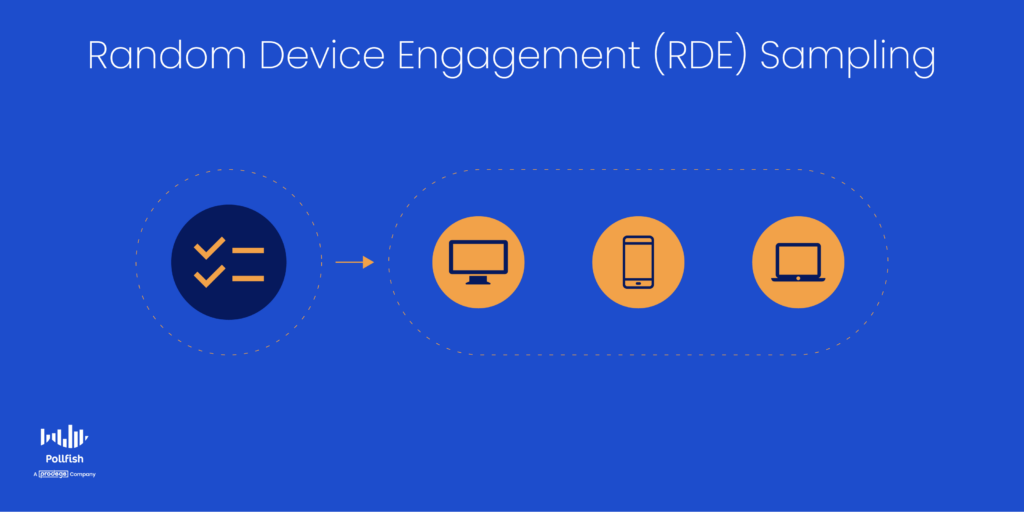 RDE sampling is a kind of organic sampling in which polling relies on advertising networks, or other portals on digital devices, to engage random people where they naturally spend time. This can occur on gaming and mobile apps.
RDE sampling is a kind of organic sampling in which polling relies on advertising networks, or other portals on digital devices, to engage random people where they naturally spend time. This can occur on gaming and mobile apps.
This is the opposite of a research panel, which is a research method that pre-recruits and prescreens a group of research participants who have opted in to take part as the studied subjects of a market research campaign.
Lastly, before we provide a few examples of survey distribution methods, it is also critical to be strategic about when to send your survey. For this, we recommend reading our quick guide on the best time to send a survey.
Here are a few common ways to distribute your surveys:
- Email. You can distribute your survey by email, especially if you have access to an established email list. The two main drawbacks of email surveys are that it’s harder to set specific target audience parameters and email response rates are generally low.
- Social media: if you survey people via social media channels, beware that sometimes social media groups attract people with shared interests that may not represent the opinion of your target audience or the general public.
- Online survey platforms: survey platforms such as Pollfish allow you to hyper-target specific audiences, control the number of participants, distribute the survey in different ways, reach all quotas, easily organize your survey results and more.
- Survey panels: A survey panel is a consistent group of survey participants, who have pre-recruited and pre-screened, who opt into a survey study. Researchers would return to the same people to run surveys or host interviews repeatedly over time.
- Syndicated research: Syndicated research refers to research conducted by a market research firm, oftentimes independently. It is published and sold by a market research firm, which is usually industry-specific and funded by several companies within a particular industry. The firm and its partner companies own the data that the firm collects. Other companies in their particular industry may purchase the data.
Besides these prominent survey channels, there are other survey solutions you can use; make sure to select the one most pertinent to your market research needs.
Step 6: Organize Survey Responses
After you’ve gathered your responses, you’ll need to organize the data before starting your analysis. As with the prior steps, this will largely depend on your survey tool, which also dictates your survey distribution, audience targeting and creation.
Here are the steps to prepare your data for analysis:
- Clean. Sometimes people fill out the survey twice by mistake. Although Pollfish survey technology prevents duplicate responses altogether, if you’re conducting a survey on your own, or via syndicated research, make sure to clean duplicates and “funny” answers before you proceed to organize your data.
- Organize. Group survey answers that are similar to each other and try finding patterns that allow you to structure your data.
- Visualize. Try finding ways of visualizing survey responses using graphs, charts and images. Visualized survey data is easier to analyze and refer to, especially if you want to share survey results with other people.
Step 7. Analyze and Present Survey Results
The data you collected during your survey can be presented and analyzed in many different ways, so make sure to go back to the survey goal that we covered in Step 1.
Analyzing survey results and writing a report often go hand in hand, so it’s a good practice to go back and forth between the two until you fully narrow down your findings.
Here are some questions that will help you write a better report:
- Did you achieve your survey goals?
- How can you organize your findings into cohesive narratives?
- What are the main insights that you gathered?
- How can you use the collected data in the future?
- Are there other ways this data can be interpreted?
Keep your margin of error in mind during your survey analysis. This measurement points to the degree of error in the results of a survey, specifically one that relies on the random sampling method.
It is imperative to keep the margin of error low, as a high margin of error reveals a smaller likelihood of survey results to reflect the true views of your survey target audience. As such, a higher margin of error renders your survey less reliable and inconclusive.
If you are presenting a report to others, remember that different audiences may be interested in different aspects of your survey.
In case your audience is primarily business stakeholders, then the main focus should be concrete customer preferences or aversions, along with actionable suggestions.
If you are presenting a survey to other researchers, they will be more interested in the technical aspects of your survey such as target audience, sample size, and data analysis method.
Make sure to consolidate your survey data analysis into one document. The document should be divided into the themes, patterns and other central areas of focus of which you’ve collected and analyzed data to draw different conclusions.
It will be this data — not the raw data in your dashboard — that will guide your business decisions, changes and all other courses of action.
Step 8: Take Action
In this step, you’re going to consult the information you’ve gathered and analyzed in Steps 6 and 7. You’ll need to create a document of your findings, one that exists outside your dashboard and is central to your survey analysis.
This document should cover central findings, along with key granular ones. It should also answer some of the key concerns you had in Step 1, along with the questions designed for your respondents themselves.
Do your results and analysis answer all the inquiries and curiosities you had about the topic at hand? If so, it is time to take action. If not, then you should create another survey, one that focuses on the things that are left unanswered, or anything you need more information on.
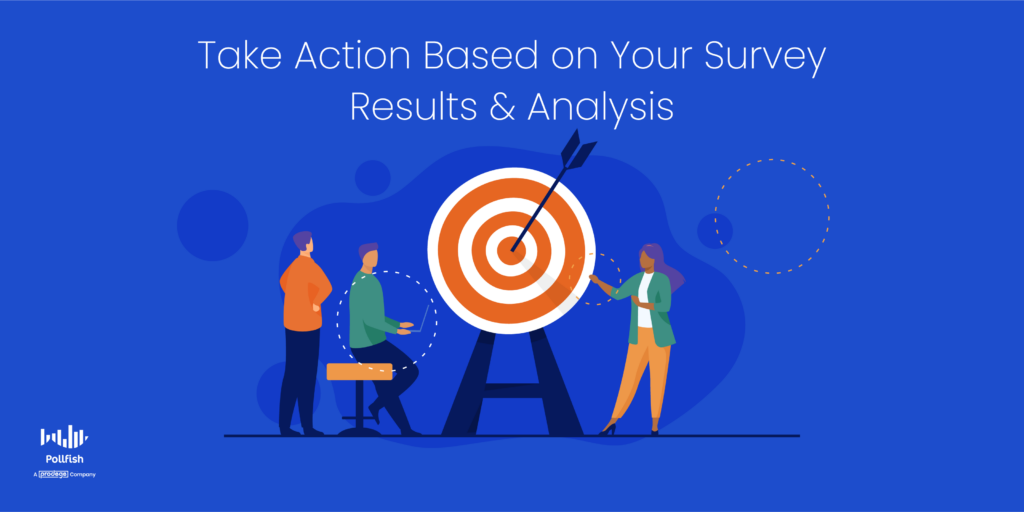
Sometimes, the latter is most common, with survey campaigns lacking clarity, therefore lacking completion. However, not to worry, just create another survey. If you have the contact information of your respondents, just send them a follow-up survey. If not, send your new survey as you had originally done.
We recommend using an online survey provider that offers the random device engagement method, which, as aforementioned, is a kind of organic sampling that uses digital properties to query respondents where they visit organically.
If, however, you have all the insights you need, it is time to take data-informed action. There are many ways to take action on any given topic. The following list enumerates various ways to act on your survey data and analysis:
- The establishment of something (ad campaigns, marketing strategy, pricing, a slogan, etc)
- Changing something already in existence (ads, videos, promotions, pricing, etc)
- Scrapping aspects of an ad, marketing, sales or any other business campaign or activity
- Terminating an action or campaign entirely
- The formation of slightly different approaches based on different market segments
All in all, after you’ve followed these steps, you will be much closer to your original goal, whether it is solely to have invaluable customer/subject data, or to use that data to make immediate or long-term decisions.
Therein lies the power of surveys, they grant you the knowledge you can use for a host of decision-making.
Making Every Survey Count
Every business has a slew of questions about its industry, competitors and customers. As such, they must use market research to crack these challenges and properly serve their target market.
Conducting a survey is at the forefront of conducting this kind of research, as it grants you firsthand insights, tailored specifically to your target market, with your most requisite questions.
The challenge in conducting a survey manifold: finding a survey solution to easily distribute your questions to the right audience, creating a survey with the proper questions, distributing the survey in the right channels, consolidating your data and more.
Following our eight steps will help you conduct meaningful and unbiased surveys to answer your most demanding questions. However, adhering to this process is not enough.
You’ll need to find a potent online survey platform to facilitate your entire survey process, from targeting, to questionnaire building, filtering data and more.
Ideally, it should provide various quality and technical checks to ward off survey fraud, offer a mobile-first survey environment and allow you to survey anyone, not just via on network on the RDE method (although this method is incredibly effective).
It should allow you to survey specific people, such as via email, or whichever digital channel you seek to use. Luckily, there’s the Distribution Link feature, which enables you to do just that.
Good luck!
Frequently asked questions
What is the first step in planning a successful survey?
Before writing questions or recruiting participants, you should establish the goals of your survey. By understanding goals, you can ensure your survey stays focused and will answer your most important questions.
Why are surveys used?
Surveys are one of the best ways to gather information about your customers or target audience. As opposed to simply researching an industry or trend, surveys let you ask specific questions to the people who matter most to your business.
Why is it important to define the target audience for your survey?
A more defined audience will lead to deeper, more relevant insights. A carefully defined audience provides more accurate results and ensures the goals of your survey are met.
How can online surveys be distributed?
Online surveys can be distributed via email, social media, or a professional survey platform.
How many people should take an online survey?
The number of respondents needed will vary from one survey to the next. The important part is that the sample size accurately represents the target audience. For most studies, a sample size of 200 - 400 is a good goal.
All About Panel Surveys: 5 Panel Survey Examples and More
All About Panel Surveys: 5 Panel Survey Examples and More
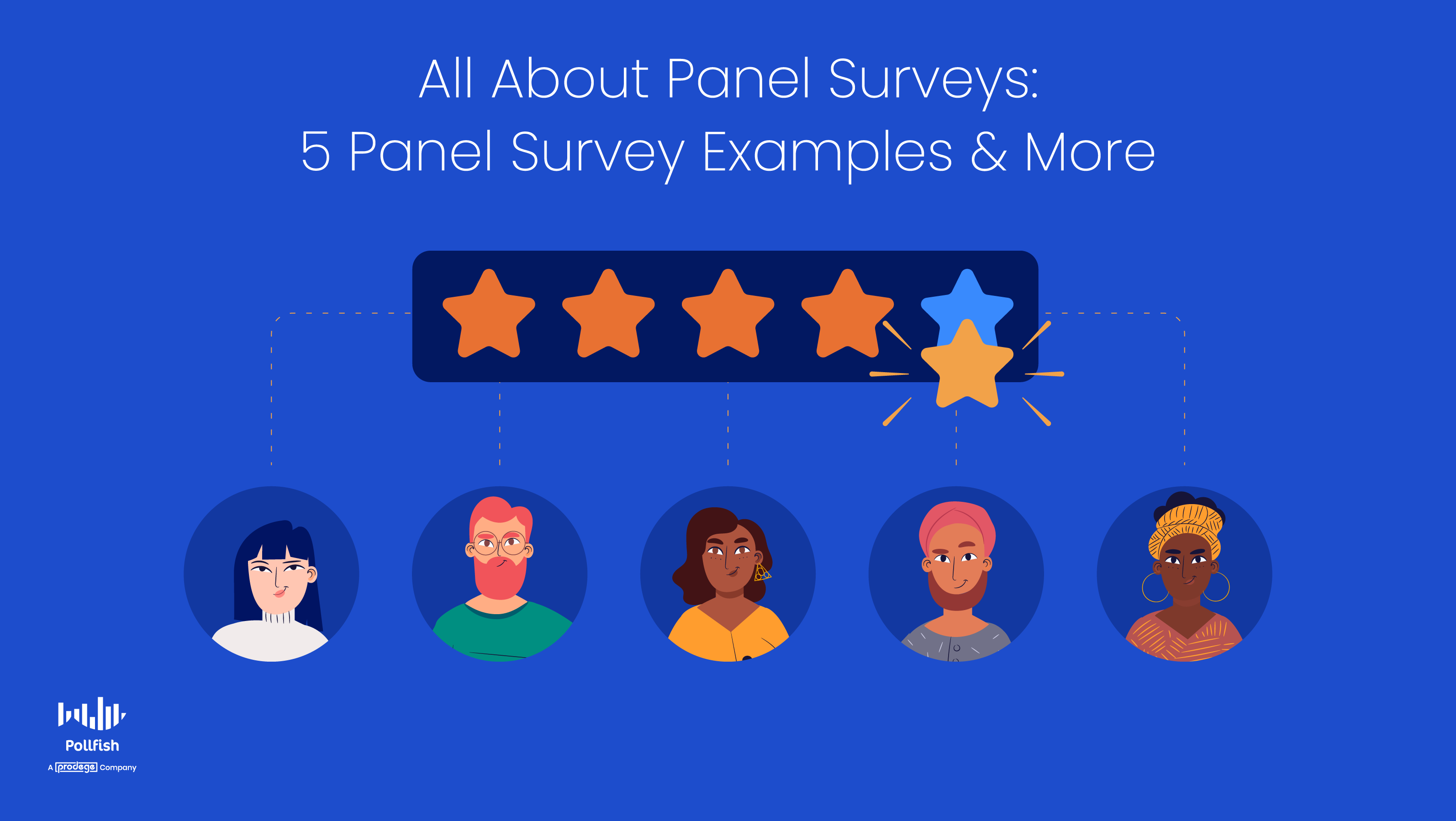
A survey panel also referred to as a panel survey, is a common research method used to gain insights from the same group of participants over a certain period.
This technique relies on examining research participants who join a market research study voluntarily. Aside from this, the participants are pre-recruited by researchers, to ensure they fit the respondent criteria they set for a particular research project.
This kind of research technique may appear to be a buzzword, given its prevalence in the market research space. However, whether it is useful and effective for your market research is entirely up to your research preferences and campaign needs.
Nonetheless, it is crucial to understand what a panel survey is before you can decide on whether you ought to implement it into your research strategy or not. Or, perhaps you want to use it in conjunction with another research method.
Either way, you should have a holistic view of everything this research method entails. This includes comparing it with random organic sampling and online surveys. Luckily, this guide provides all of this information and more.
This guide explores panel surveys, explaining them in full depth, along with their pros and cons, 5 examples of them and a comparative analysis of random sampling and survey panels.
Note: If you’re looking to do market research without the drawbacks of conducting panel surveys, try Pollfish. Our unique methodology guarantees authentic high-quality data, and it’s a fast and reliable way to survey targeted (yet randomized) people while they’re already engaged on their devices.
All About Panel Surveys: Table of Contents
- Defining Panel Surveys
- Panel Surveys: A Kind of Longitudinal Study
- Using Panelists in Your Target Market
- What to Study with a Panel Survey
- The Importance of Panel Surveys
- Panel Survey Examples: What Do Researchers Use Panels For?
- Pros & Cons: The Advantages and Drawbacks of Panel Surveys
- Organic Sampling: A Better Alternative to Panel Surveys
Defining Panel Surveys
Also called survey panels, panel surveys are a distinct form of market research that relies solely on panels to carry out the research study, as its name suggests.
Thus, it’s key to understand what the term “panel” means in the context of market research. A panel is a selection of participants who help researchers conduct market research by providing them with feedback on various studies.
The panelists do not join the study randomly, rather they are pre-recruited and pre-screened, based on the researcher’s panel needs and criteria.
A kind of research panel, a survey panel operates in the same way, except that it is strictly used within survey campaigns. As such, this panel is used for survey research alone, as opposed to other methods of panel usage.
Panels can be used in various research settings, including the following:
- One-on-one interviews
- Focus groups
- Survey studies
- All 6 main types of research, which include
- Exploratory research
- Correlational research
- Causal research
- Descriptive research
- Experimental research
- Explanatory research
- Field research
In the context of this guide, we’re going to focus on panels used in survey research alone. Hence, they are called survey panels, or panel surveys.
One of many market research techniques, this kind of research process uses a consistent group of participants, with the researchers returning to them repeatedly, either for a single survey campaign, which can require using multiple surveys or for multiple campaigns.
Panel Surveys: A Kind of Longitudinal Study
It is important to know that when referred to as a panel survey, this kind of research method is known as a longitudinal study. As such, this process is paired with longitudinal surveys.
This type of research study is often associated with correlational research.
As a type of longitudinal study, panel surveys involve correlational research because they examine the relationship between variables over an extended period. The period itself can vary.
As such, this kind of research method can be conducted in the following ways, occurring throughout:
- Weeks
- Months
- Years
- Decades
Regardless of the time dedicated to performing this research, it always involves the same survey target audience. By surveying the panelists at different points in time, researchers can glean a wide variety of changes and consistencies within their research subjects, aka the panelists.
Using Panelists in Your Target Market
While the panel remains the same, the topic(s) that can be scrutinized are virtually limitless.
For market research, the topics deal with a business’s target market. As such, all members of the panel survey must also have the qualities of those in your target market.
You can perform panel survey studies by zeroing in on your target market’s various market segments and customer personas. These are more distinct and defined groups of people who fall under your customer base.

This is the ideal way to conduct this kind of research and many others, as your target market can include a wide range of subgroups, whether they differ based on the following categories:
- Geographical locations
- Demographics
- This involves groupings based on gender, age, income level, ethnicity, employment type, education, etc.
- Psychographics
- This involves their attitudes, lifestyles, aspirations, values and other psychological criteria.
- It also involves whether they engage in a particular customer behavior.
- Firmographic
- This label is particular to studying a panel of business personnel, which you may do in B2B research.
- As such, it requires running B2B surveys.
Whichever categories you intend to group your panelists into, remember that they must fit into the qualities of your target market, as this group is the population of people most likely to purchase from your business.
What to Study with a Panel Survey
As aforementioned, you can explore a wide variety of topics in your panel survey. The following list enumerates some of these topics. Note that this is not a comprehensive list, as various other topics of concern may crop up, depending on your business, your customers and your research needs.
Here’s what this kind of research method allows you to study:
- Changing attitudes, opinions and sentiments
- Changes in customer buying behavior
- Changes in customer lifestyles
- Changes to consumer preferences
- Developments in your target market needs
- How your target market views your competitors
- The willingness of your customers to make repeat purchases
- Gaining a more in-depth glance at your market segments and customer personas
- Performing time-based research, such as longitudinal studies, retrospective studies and prospective studies
- Acquiring a snapshot of the present through cross-sectional studies
In this post, we’ll look at five-panel survey examples, which delve deeper into some of the topics on this list. But first, we’ll explain why this research method is important for researchers and their market research campaigns.
The Importance of Panel Surveys
Panel surveys are important for a variety of reasons. Some of these reasons may hold more weight than others, depending on your research needs and preferences.
Firstly, these panels are ideal for longitudinal research, as the same group of participants agreed to partake in your study. You would make it known that they would be used in continuous studies.
Aside from facilitating longitudinal studies, panel surveys are also ideal for another time-based research campaign: retrospective studies. As such, these panels aid researchers in completing their retrospective surveys.
This kind of study is used to examine changes over a long period, except the survey itself is only administered once. That’s because retrospective studies invoke occurrences from the participants’ past, whether they are experiences, inclinations, feelings, or attitudes.
The study may ask participants to compare past phenomena with how they feel in the present. The purpose is to study historical data and compare it with the present.
Panel surveys are also necessary for prospective studies, which also can last for years and study changes and developments. However, unlike retrospective studies, they involve participants who do not have a certain outcome. Instead, prospective studies seek to study people before they develop a certain outcome, such as a disease or a new shopping habit.
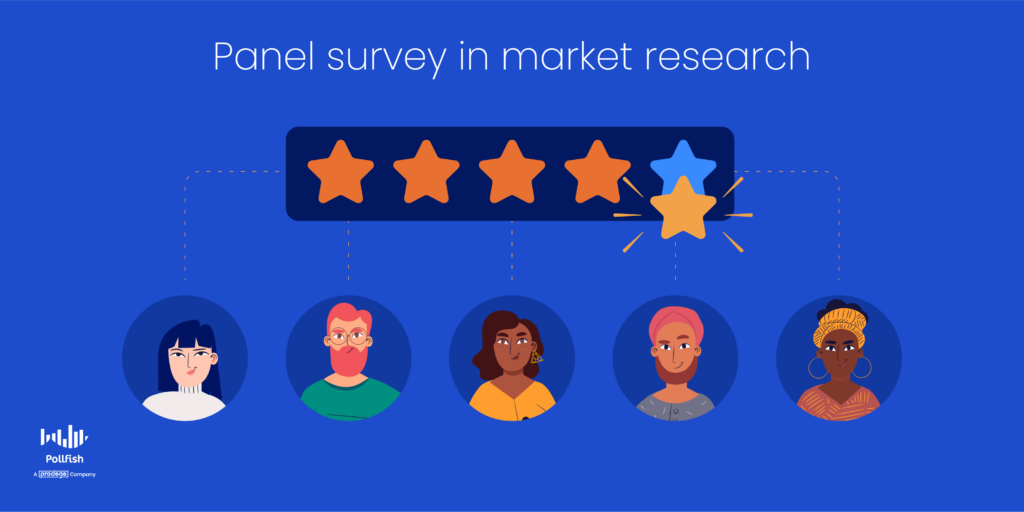
Aside from enabling researchers to study changes, these panels also make it possible to conduct cross-sectional studies, which are different from the prior three kinds of research studies — longitudinal, retrospective and prospective studies. Nonetheless, cross-sectional studies are still one of the key survey research methods.
As opposed to studying survey subjects at multiple points in time, a cross-sectional study entails gathering research about a particular population at one fixed point in time. Because of this, this type of research method is often referred to as a snapshot of a studied population.
This kind of study is conducted by using cross-sectional surveys, which are designed specifically for the cross-sectional model and can be sent to your panelists. Although cross-sectional studies don’t require a panel survey, given that they focus on a single point in time instead of several to examine changes, they can still be administered via these panels.
That’s because you can recruit panels for virtually any study, whether it includes partaking in a survey, an in-person interview, field research, or a focus group. Thus, panel surveys are not limited to any form of study, making them multifunctional.
This grants plenty of convenience to researchers, especially those bogged down by various other tasks they have to uphold, instead of putting together a group of respondents.
Panel surveys are especially important, as they provide an ongoing sampling pool of participants, which researchers can turn to whenever they seek to conduct more research. This can be to jump-start a new research campaign or conduct further research for an ongoing campaign.
This constant access to a sampling pool can also assist researchers who initially thought they had enough data, only to later discover they need more information. After all, if the panelists have already opted in, there is no need to seek out participants any further.
Panel surveys are also useful due to the quality of the panelists. Although identifying and vetting panel members may take some time, the result is a quality survey panel, one that ticks off all the panelist criteria you have. With this, you can mitigate fraud and rest assured you’re studying the correct populations.
All in all, panel surveys are useful for a variety of market research campaigns and come with a good share of benefits, despite some of their shortcomings.
Panel Survey Examples: What Do Researchers Use Panels For?
Now, let’s get to the heart of these panels, by going over what they can consist of, when, where, and how to use them.
The best way to explain the uses of a panel survey is by providing several panel survey examples. In this section, we’ll review five examples of when panel surveys can be used to good effect.
This will allow you to understand how panels work, along with some of their best-case scenarios for usage.
Example #1: Tracking Changes Over Time
Given that studying changes over time is the main purpose of leveraging a survey panel, it’s key to review this use case.
As such, one of the strongest examples of a panel survey is when researchers ask the same question(s) to a group of the same participants over a long period.
For example, if you were conducting a sociological experiment to understand if (or how) age correlates with wealth, you can set up a survey that studies panelists on the following:
- Income
- Expenses
- Assets
- Changes in employment
- Willingness to change jobs
- Willingness to switch job fields
A survey covering this topic ought to be conducted every two years, possibly spanning a decade (or more if need be).
That way, you can track changes relative to the scope of the issue you’re researching. Given that people typically stay at a job for about two years, it is key to follow up every two years on this research subject.
However, this has changed due to the Great Resignation, which saw the largest exodus of employees quitting their jobs in recent history.
The Great Resignation is not slowing down any time soon, with large numbers of people seeking better pay and benefits, along with the rise in job openings and remote work. This makes it much easier to switch jobs.
As such, the length of time you devote to tracking changes will depend on the circumstances of your study.
Alternatively, if you run a business, you’ll need to acquire ongoing insights into the market – and into audience behavior. For example, if your gym wear company wants to track the fitness habits of people over the year, a panel can be questioned every three months. You can run surveys with the same questions about how long people exercise, where they exercise, and how they do so.
For any business endeavor, you can implement the brand tracking survey, which allows you to track any changes that deal with your brand. This involves studying how your business is perceived, how in-demand its offerings are, what concerns your target market has that your business can address and much more.
Example #2: User Experience Research
Another common example of using a panel survey is for UX and UI design research. While UI refers specifically to designing web experiences, UX is far broader.
User experience can refer to a wide range of experiences that your customers encounter when interacting with a product, digital experience, or service. As such, it covers a wide range of aspects, all of which have some impact on how users experience your business’s offerings.
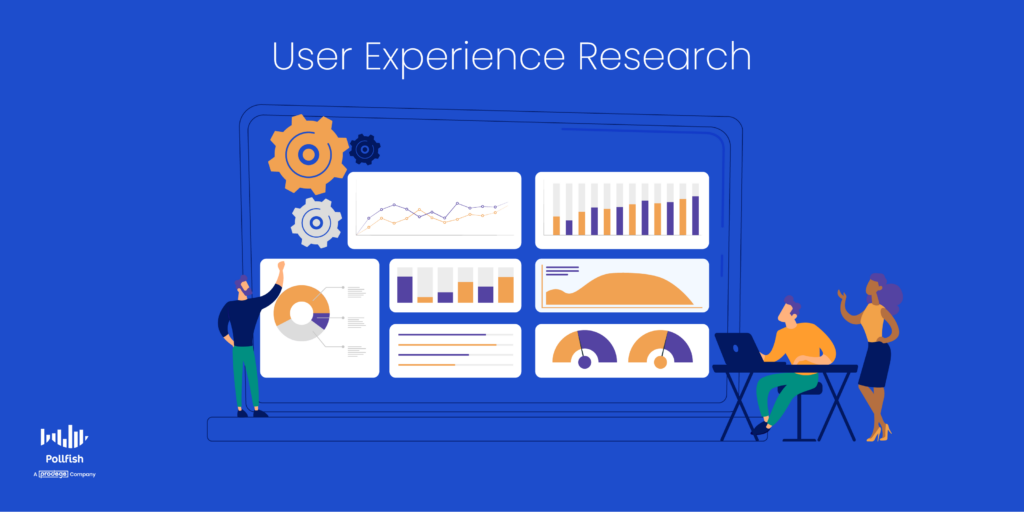
You can use these aspects as key considerations for driving your UX research. The following lists the four key components of user experience, which you should use in your research:
- Value: Does this experience give customers value?
- You can ask your panel whether a certain product, service, or digital experience provides them use and how so.
- It is key to study how your offerings can be made more valuable.
- Also, you should inquire about the products/services that your customers don’t find useful.
- Function: Does a product or product feature work?
- Ask your panel whether there are any bugs or glitches in how a product, feature, or service works.
- You can also study whether new needs arise in terms of your product’s functionalities.
- Usability: Is it easy to use?
- While your offerings may provide value, ask your customers whether they are easy to use, regularly.
- Study if your offerings can be made simpler over time.
- Also, look into whether customers seek other ways to access your offerings.
- For example: different devices, operating systems, web and app access
- General impression: Is it pleasant to use?
- Track changes to the overall sentiment towards your products, services and business at large.
- Ask your customers whether your offerings delight them or upset them.
- Ask customers to reveal anything else they’d like to see from your business to improve their UX.
When a company is building an app or a digital product, they want to gauge the customer experience as they go.
While usability testing (i.e. tracking how a person interacts with a specific feature), is often done using different methods, you can conduct qualitative research about design and experience by way of panel surveys.
The benefit of a panel survey here is that the participants remain constant – which removes a key variable.
Additionally, you can select panel participants based on their background or expertise, which will allow your pool to answer questions in a way that adds value to your product development process.
Example #3: Customer Satisfaction Surveys
Customer satisfaction is central to keeping your business alive, whether you want to release new products or build a steady base of loyal customers. As such, you can use panels to keep a watchful eye on your customers' satisfaction with your business.
Doing so will allow you to increase your customer lifetime value, a metric that measures the total monetary value a customer will bring to a business during their relationship with the business throughout their lifetime.
If you want to gauge customer satisfaction and positive/negative sentiment over the lifetime of their interactions with your offering, use a select group of long-term customers and ask them questions periodically about your value proposition.

Use a customer satisfaction survey for this campaign, which can be framed to reveal hidden sentiments, or can be explicitly focused on asking how satisfied they are with what you offer.
For example, use the following questions/considerations to measure customer satisfaction:
- On a scale of 1-10, how satisfied are you with [a product, service, experience]?
- A rating scale question
- What would you change about [a product, service, experience, or your company] if you could?
- Open-ended question
- How easy was it for you to [do something] with our product?
- Options include a scale of extremely easy to extremely difficult
- This is a Likert scale question,
- How would you rate your experience with our new [a product, service, experience]]?
- This can be a Likert scale.
- Or, it can involve multiple choices of varying answers.
In this panel survey example, the business would be able to track patterns of customer happiness over time – for example, to see whether features continue to add value months or years after the customer signs up. And you can incentivize participation with gifts, reduced subscription fees, or extra services.
Consider discussing the following topics with your panel:
- What are their overall thoughts about your business?
- How do they receive product updates? (Poorly, well, etc.)
- What kind of value does your business provide and where does it lack in value?
- What else can you do to delight your customers?
Example #4: Employee Engagement
Another crucial panel survey example deals with studying your human capital, aka, your employees. After all, it is the employees that allow your business to function daily.
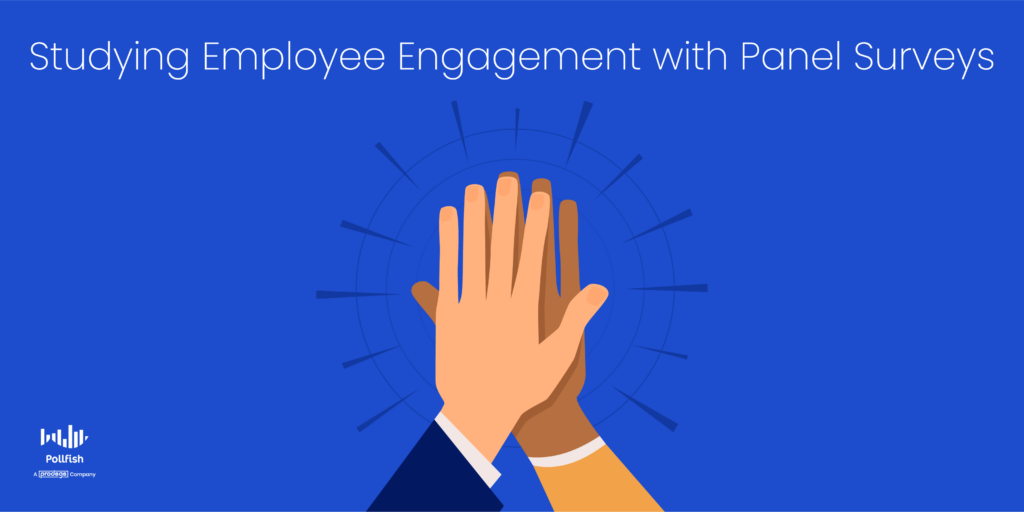
As such, your business needs to track employee engagement and team morale. In essence, here, your staff are the members of the panel survey – and you might survey them every week, month, quarter, or year. In this case, you’re surveying the same people about issues that answer the following:
- Are employees engaged at work, or do they have low morale?
- Do employees enjoy their work?
- Are they meeting their goals?
- Do they understand the company's mission?
- Do they understand the company roadmap and high-level goals for the coming weeks and quarters?
- Are they happy with their compensation?
- Where can the company improve?
If this is the type of panel survey you’re looking for, there are plenty of surveys that are specialized for human resources and employee engagement purposes.
This includes the following surveys:
- The employee satisfaction survey
- Used specifically to measure satisfaction, this survey focuses on what customers like and dislike about their jobs and the company,
- The employee feedback survey
- This is a general survey that should handle high-level topics.
- The employee burnout survey
- This survey focuses on the negative aspects of employees’ jobs and your company.
- You can use it to avoid burnout by asking them what they’d like to see change in their employment, workflows, job processes, schedules, etc.
- The employee recognition survey
- This is conducted to measure and understand the degree of employee recognition within a business.
- It gauges the perception of recognition that employees feel they have from their managers, peers and the company at large.
- The eNPS survey
- This functions the same way as a Net Promoter Score survey but for employees.
- Employees are asked how likely they are to recommend their company to others, on a scale of 1-10.
- The employee retention survey
- This is used as an instrument to retain employees.
- It delves into the topics that business owners and HR workers need to understand, to forge ideal work environments and cater to the needs of their employees,
Example #5: Customer Loyalty
It takes years to build solid consumer loyalty, which is a must, given that it is the core of the aforementioned customer lifetime value. By retaining your customers, you’ll spend less on attempting to acquire new ones, have a steady pool of revenue and maintain a good brand reputation.
Your panel survey can help you keep track of your customer loyalty. As you gain their insights, you’ll discover how you can raise their loyalty to your brand. To do so, use a market research platform that offers a brand tracker.
This tool allows you to keep track of a variety of brand issues throughout the year and beyond. It enables you to uncover whether there are any shafts in your brand perception or reactions to your marketing campaigns.
Consider tracking the following on customer loyalty:
- What excites my target market about your offerings?
- What kind of brand news incites the most interest?
- Which segments of customers are most likely to make repeat purchases?
- Which customer groups are the most loyal to your brand?
- Which actions and offerings inspire loyalty to your brand?
Pros & Cons: The Advantages and Drawbacks of Panel Surveys
Now, it’s time to analyze the advantages and disadvantages of using panel surveys for your market research.
One of the primary advantages of a panel survey is that the participants learn to trust the researchers, and therefore may be open to deeper and more truthful answers.
In addition, this ongoing relationship can allow researchers to dig deeper with follow-up questions.
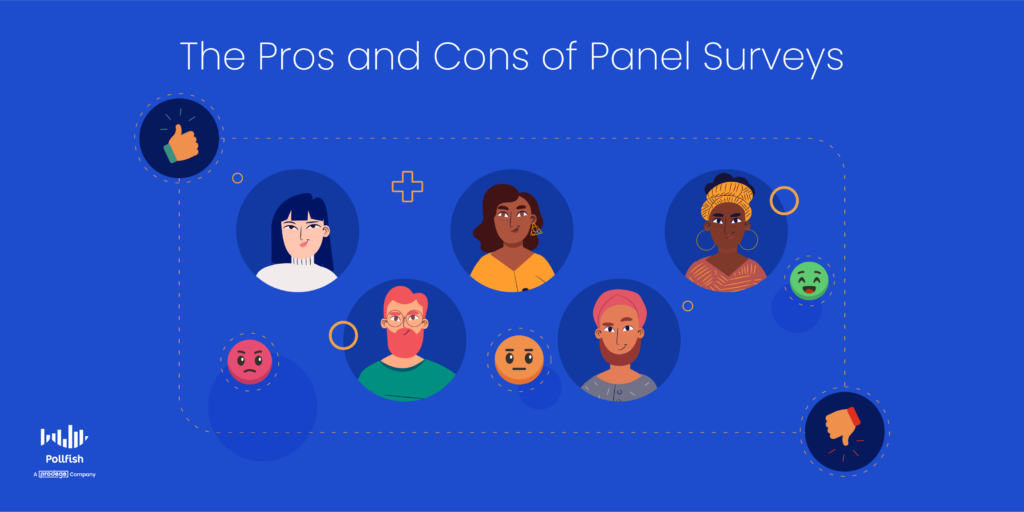
Another advantage is that with screening having occurred at the start of the research, all following surveys are quicker to carry out than starting from scratch.
However, the disadvantages of panel surveys include:
- Panel conditioning: When you’re surveying the same people repeatedly, previous surveys might influence their responses and/or behavior. For example, if they know a certain question triggers a longer process, they may choose an answer that offers the path of least resistance. Or if you’re asking about a particular activity, like eating donuts, they may eat less (or more) thereafter.
Note: Furthermore, panel surveys don’t tend to occur within a “natural” setting, and therefore the artificial environment might affect thought processes and responses to questions. - Panel fatigue: If a person feels like a pay-off for participating in a panel survey is no longer worth the effort, the quality of their response may drop. This leads to incomplete or poor-quality survey responses, and survey “straight-lining” – i.e. answering the same to every question.
- Declining participation: Over time, inevitably, participants will drop out of the process – either due to panel fatigue, or other reasons. This will damage the quality and depth of your data.
And with survey panels, you run the risk of accidentally signing up “professional” panelists – especially when there are cash-based incentives on offer. Though screening should be designed to pick up these people before they enter the process, they’re adept at slipping through the net.
Organic Sampling: A Better Alternative to Panel Surveys
With increased pressure on people’s time, survey response rates have been decreasing. It’s harder than ever to guarantee consistent high-quality data, and as conventional survey companies scramble to include as many willing participants as possible, the quality reduces yet further.
At Pollfish, we don’t use conventional panels. Our unique methodology, called Random Device Engagement (RDE) uses the organic sampling approach for finding and procuring survey participants.
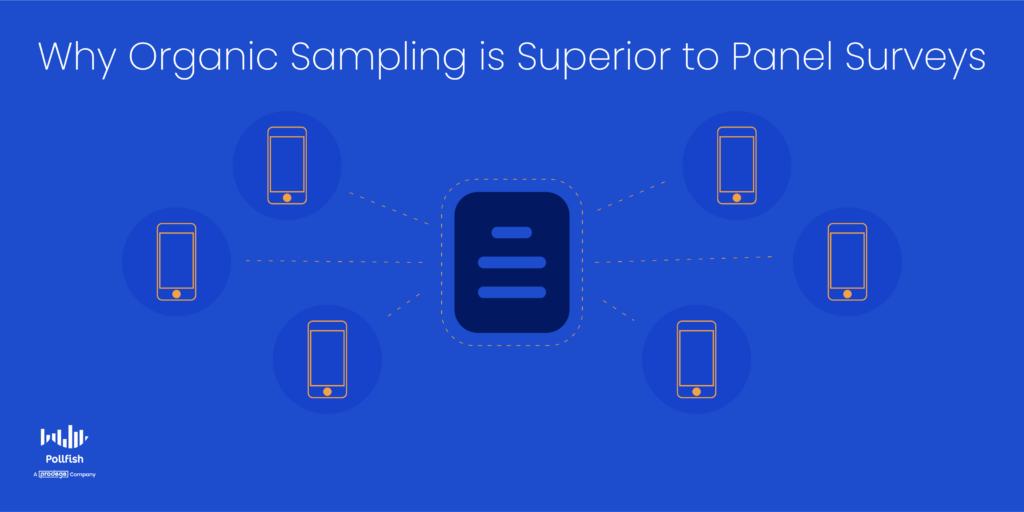
A kind of organic probability sampling, RDE polling relies on advertising networks and other device portals to engage potential respondents wherever they are voluntarily. This includes a variety of digital platforms and properties, such as:
- Mobile sites
- Apps
- Website
- Mobile games
All respondents gathered via the RDE method have no biases, as they are not pre-recruited and therefore face less pressure to answer things in a certain way. Due to this, they are less subject to a wide host of survey biases.
This includes the following survey biases:
- Sampling bias: This bias occurs when the respondent selection process, specifically when a survey sample is not chosen at random.
- This leads to under or overrepresentation of a certain segment of your survey target population, as only certain types of respondents are going to partake, while others aren’t.
- Acquiesce bias: Also called agreement bias, this occurs when respondents gravitate towards positive or agreeable answers.
- In this bias, respondents feel more social pressure to answer in a particular way, as their identities are known in panel surveys.
Organic sampling and Random Device Engagement obliterate these two (and other) biases. That’s because this process is completely randomized, stamping out sampling bias. Not only does it reach people randomly, but on Pollfish, this method is paired with our state-of-the-art survey platform.
Our online survey platform reaches specific populations based on demographics, psychographics and specific screening questions you can input. This ensures you’ll reach all the required target audiences to partake in your study.
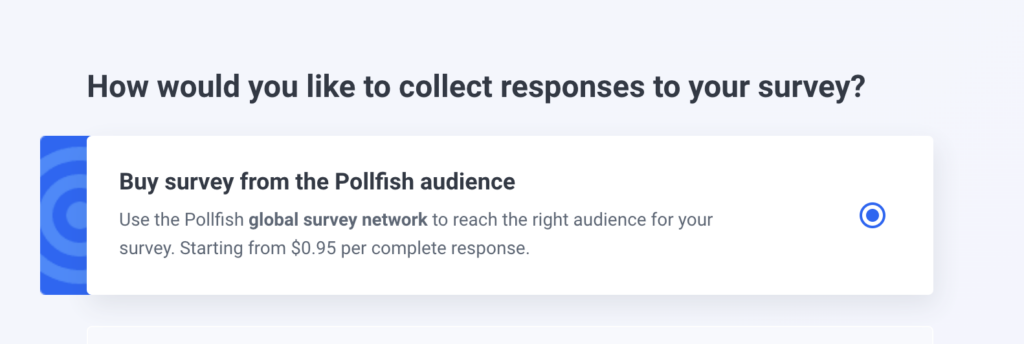
Aside from reaching respondents organically and randomly, the respondents are completely anonymous. They don’t need to provide their names, contact information, or any identification to take a survey. Instead, they are simply reached and opted in.
They may also have the option of gaining survey incentives. This eliminates virtually all forms of acquiescence bias, as there is no pressure to provide certain answers over others.
Each screened participant has a unique ID, which prevents them from taking the same survey more than once, weeding out bias and survey fraud.
When working with Pollfish, you don’t need to use conventional panels – which are slow and subject to conditioning, fatigue, and declining participation. Instead, get authentic insights from our pool of over 250 million people (and growing) – who are already engaged on their devices and ready to participate.
As such, organic sampling, coupled with a potent online survey platform like Pollfish, provides a better market research option over panel surveys.
A panel survey is a type of survey method that involves repeated interviews of a group of people over a specific period of time. A longitudinal study is another term used to describe panel survey. It refers to any study that examines the same group of people over a period of time. Panel participants often learn to trust the researcher and may reveal deeper, most honest insights. This type of survey is also a good way to track progress or evolution over time. Panel fatigue occurs when the participant no longer feels that the reward for participating in the panel is worth it. If panel fatigue occurs, the participant may not give deep answers, but instead try to answer the questions as quickly as possible. When interviewing the same people repeatedly, the answers to previous surveys may influence their behavior by causing them to reflect on activities that they previously gave little thought to. This influence is known as panel conditioning.Frequently asked questions
What is a panel survey?
What is a longitudinal study?
What are the benefits of panel surveys?
What is panel fatigue?
How can panel surveys influence participant behavior?
The Complete Guide on Market Research vs Market Analysis
The Complete Guide on Market Research vs Market Analysis
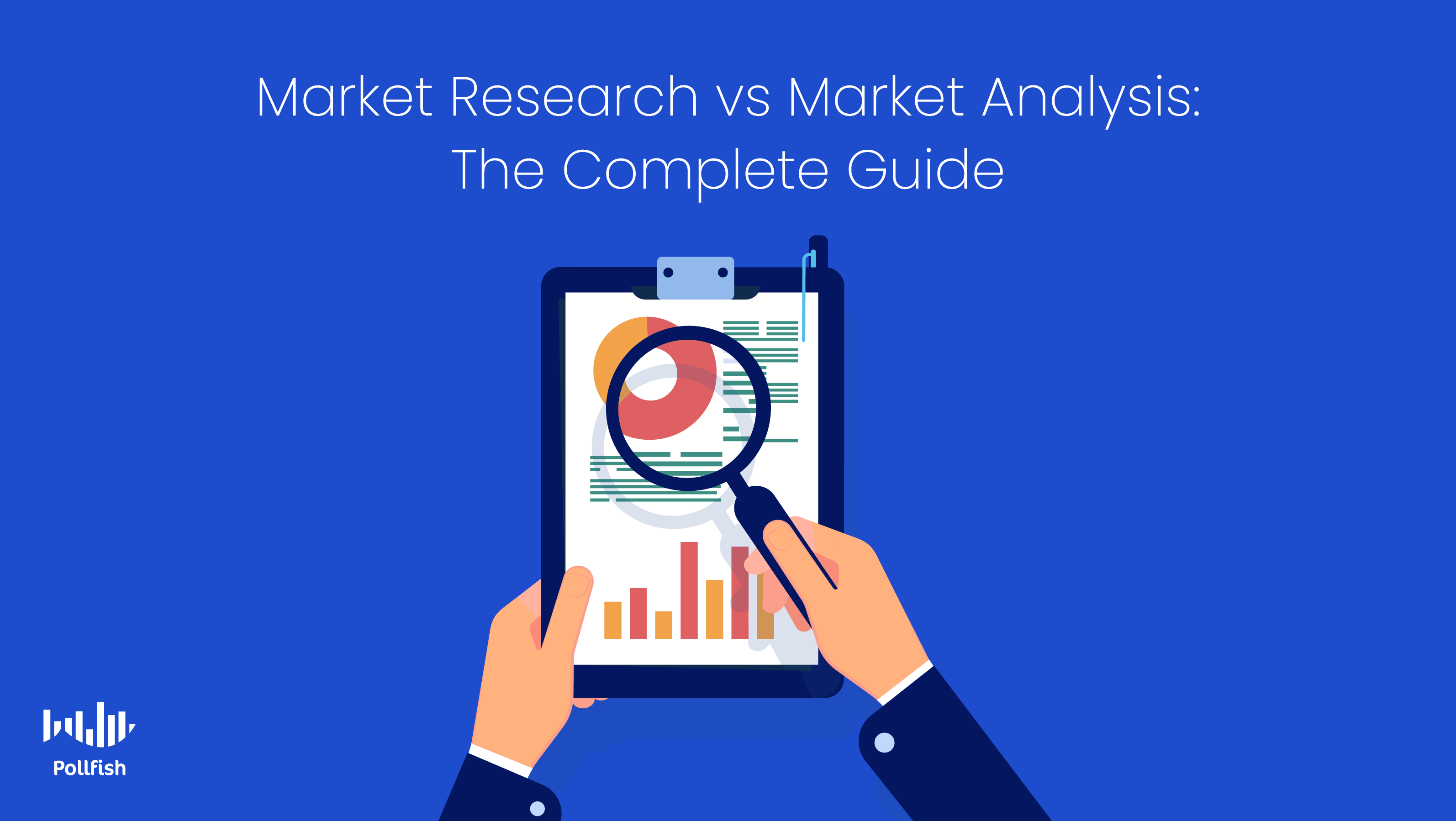
Market research versus market analysis. This is a topic of contention for many in the business and research worlds. Both of these concepts yield critical data and intelligence for businesses and both of them are necessary to sustain a business.
Both market research and market analysis empower businesses to analyze areas of their industry, predict future trends, hone their business practices and lead organizations effectively. They both deal with big data problems from time to time. Both of these concepts also allow businesses to assess industry expectations and meet them.
However, although these terms are used interchangeably and offer similar business benefits, they are not the same thing, as each represents different key factors, processes, objectives and methodologies.
We’ve taught you about the differences in market research vs. user research. This guide lays out market research vs. market analysis, allowing you to understand all of their key facets and differences, so that you can understand when and how to apply both.
Understanding Market Research
Market research refers to a process that is far more specialized than market analysis, as it entails examining a specific market and its corresponding customers. It is usually bent on answering distinct questions regarding customer behavior along with all else that pertains to a target market, which is the group of consumers most likely to buy from a business.
Market research involves studying customers at an in-depth level, which therefore includes segmenting them into distinct groups and designating them with individual customer personas. This involves the practice of performing market segmentation, along with conducting secondary and primary market research techniques prior, during and after administering market segmentation.
Aside from referring to and implementing primary and secondary resources, market research encompasses both quantitative market research and qualitative market research methods.
Given that this kind of research is centered around customers, it examines a variety of customer traits and characteristics. They include the following:
- Customer buying behavior
- Customer preferences
- Desires and needs
- Customer aversions
- Opinions and sentiments in regards to
- Values
- Products
- Cultural trends
- Current events
- The industry at large
- Prices
- Lifestyles
- Behaviors
- Customer experience (CX)
- Views on the industry at large
- General feedback
Market research is a practice undertaken by business owners, researchers, analysts, marketing departments and even individuals. Essentially, market research is used to gather feedback and data directly from the customers, mainly to assess the viability of particular business decisions.
The Importance of Market Research

Market research carries a great deal of importance, as it empowers all businesses with critical data that steers them towards making the right business decisions.
Firstly, it’s important for startups and new businesses to conduct market research before launching their business or even innovating on a product. Although it is tempting to push a product to market, a lack of market research has grave consequences.
It is difficult to acquire new customers for established businesses, as it costs five times more to acquire a customer than it does to retain an existing one. Additionally, selling to a new customer has a low success rate of 5-20%, while selling to an existing customer has a success rate of 60-70%.
This environment exists for existing businesses. It is even more arduous for startups and yet-to-be registered businesses to gain a customer base. As such, these businesses must conduct market research. It grants them valuable knowledge about the particulars in their industry and most importantly, their target market.
Only when you understand your customers can you serve them properly. After all, you're not just selling a product or service. Businesses of the present can only survive if they provide a strong experience for their customers. 73% of U.S. customers say that CX is a very important factor in their purchasing decision. 1 in 3 custumers will leave a company after just one bad experience.
Clearly, customer experience is vastly important and in order to create positive experiences that not only draw in but retain customers, you’ll need to understand your customers at a deep level.
Market research makes this possible, as it allows you to learn everything about your target market, segment them into smaller, more distinct groups that you can dedicate to different campaigns and satisfy them continuously.
Understanding Market Analysis
Market analysis is the process of examining a particular market, industry, niche or segment. It is carried out by way of quantitative and qualitative assessments of a market.
This analysis relies on raw data that predominantly focuses on a market's size and potential. As such, it involves studying a market by observing various factors that involve these two concepts.
A market analysis involves observing the following aspects: market volume, value, its different customer segments and their customer buying behavior, economic conditions, regulations, the competition, barriers to entry and political, social and cultural trends, as they relate to the market.
A market analysis uses current and historical data to forecast future market events and outcomes. This data includes information on the above topics of observation. Businesses use market analyses so that they can understand how their products and experiences may exist under a certain environment.
This kind of analysis allows companies to plan ahead for the future in a strategic way, using data for decision-making. This is because it allows companies to get a plain understanding of the most important factors of their market.
A market analysis is an all-encompassing practice of examining a market, therefore, it uses a wide range of sources. This involves using market research to provide key information on customers and other aspects of the market. By relying on a vast number of sources, a market analysis can assess and predict all of a business’s growth options, as well as its possible stumbling blocks and limitations.
In short, a market analysis gives businesses a broader understanding of their market by relying on multiple means and sources of data that pertain to various aspects of the industry.
The Importance of Market Analysis
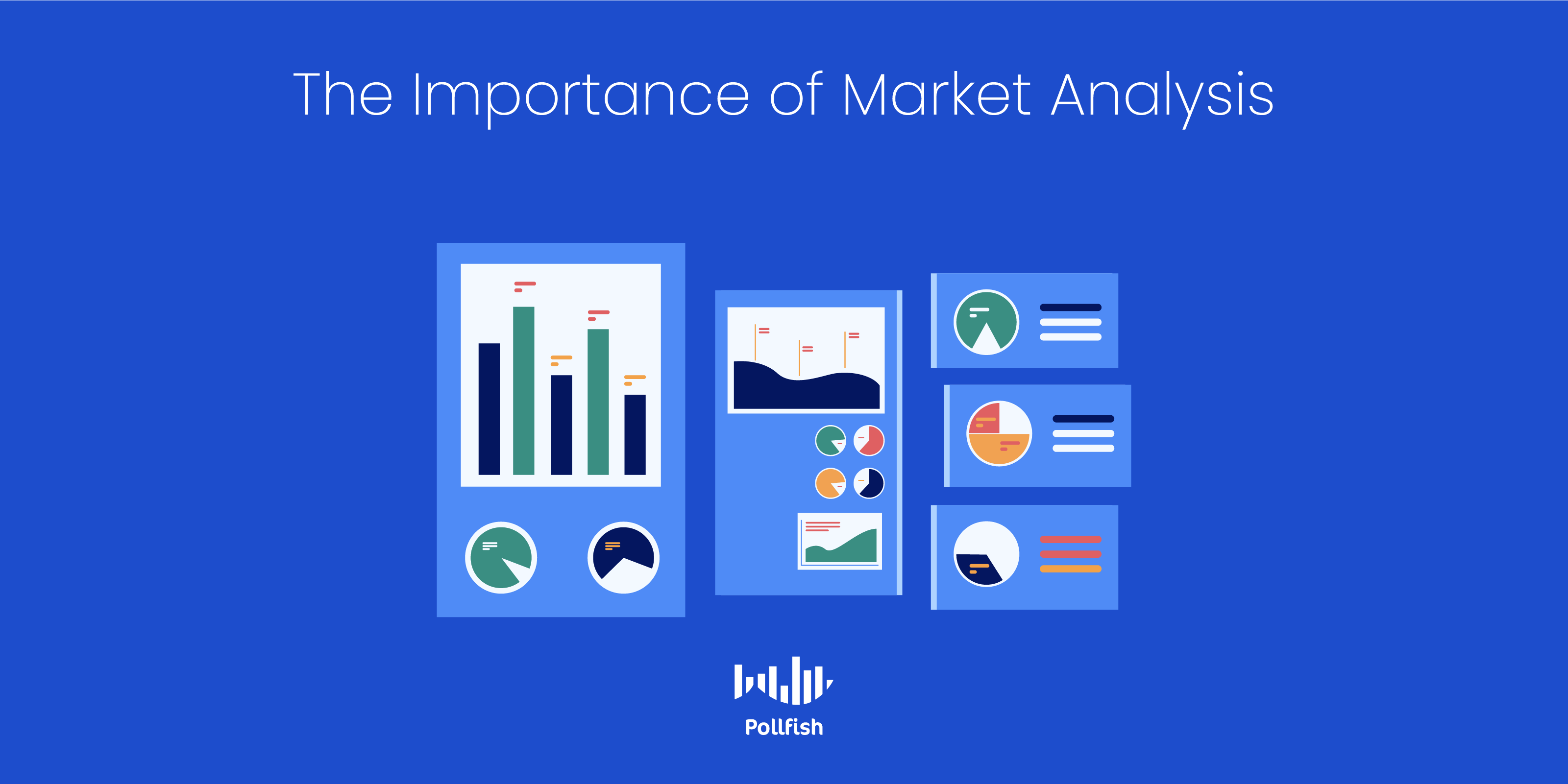 Market analysis is important for a variety of reasons. Almost every successful product or service of the present involves having conducted a thorough market analysis. This analysis is often the first and the most significant stage in the development of a marketing and business plan.
Market analysis is important for a variety of reasons. Almost every successful product or service of the present involves having conducted a thorough market analysis. This analysis is often the first and the most significant stage in the development of a marketing and business plan.
The process of a market analysis is important, as it allows business owners to evaluate whether their product or service will satisfy their customers’ needs. This way, they don't waste time on producing products, product updates and features that will perform poorly and generate few sales.
A market analysis helps gain insights into the shifts occurring in the economy. This can include changes in regulations that directly or indirectly affect your business. It also helps you stay aware of market trends, which puts supply and demand in perspective.
This helps you set reasonable prices that are commensurate with demand. It allows you to understand the desirable products and services along with those that drive little demand. These key aspects enable your business to become fully acquainted with the economy, along with the particular one of their industry.
In addition, this kind of analysis is important in that it provides insights into your target market, the segment of the market most likely to be your customers. It does so, as it involves studying your demographics along with their behaviors, traits and expenditures. In this sense, market analysis is critical as it implements market research.
Furthermore, a market analysis will help you plan the most promising strategy to market your product or service product. This is because when analyzing the key facts of your market, many marketing messages will come your way.
Even by casually browsing your competitors’ sites and social channels, you’ll discover various marketing techniques, from ads, to landing pages, webinars, promotions and much more. This will give you critical information on the kinds of marketing methods to test and try.
Given that a market analysis touches on so many components of a market, it equips businesses with essential knowledge for making auspicious business decisions. This kind of knowledge allows you to complete a business plan, as it has its own section, showing prospective and plausible investors that you understand your market.
The results that your market analysis draws enables your company to identify both the opportunities and risks of your particular market. All in all, this kind of analysis sheds light on all the foundational aspects of a business, along with its main ongoing concerns. This kind of knowledge will inform and bolster all kinds of business endeavors.
The Key Differences Between Market Research and Market Analysis
There is considerable overlap between market research and market analysis, given that some market research projects may include a market analysis and especially since market analysis encompasses market research.
Additionally, you can complete both a market analysis and market research for a business plan. You can use both of these insights-rich methods to support a wide array of different documents and reports. Both of these can point you to the appropriate action based on the data you collect.
However, these two terms are not the same and should, therefore, not be confused with one another.
The main differentiating factor between them is that market research is inclined on gathering customer-specific intelligence. Market analysis, on the other hand, seeks a far more expansive perspective of a market, thereby relying on more resources, to execute all the possible business forecasts and examine all growth options.
Whereas market analysis is broad, market research is much more specific and fine-tuned. Market research is therefore restricted by the population of studies, emotions and time, as well as different kinds of human interaction.
In contrast with market research, market analysis works by depositing large quantities of data into a large storage framework. Market research works by collecting specific data points necessary for answering certain research concerns.
Market analysis often yields results that last in the long-term, while the results of market research tend to be valid for several months to years, depending on the population and theme of the study, given that public opinion can change quickly.
In conclusion, market analysis strives to render a clear picture of the majority of a market, while market research is focused on understanding its customer base and those possible prospects.
Reinforcing All Your Research and Analysis Needs
Market analysis and market research are two exceedingly important processes of gaining information to bolster your business. Despite their similar nature and often conflation, they are two distinct practices and should not be mistaken for one another.
However, in order to conduct market research and even garner intelligence for market analysis, your business ought to use a strong online survey platform. It can be used to study your customers on a deep level, along with what people perceive in your market. You can also send surveys to specific people with Link Distribution, allowing you to better understand your market by surveying key players.
To do so, you ought to look into a strong online survey platform, the kind that operates via random device engagement (RDE) sampling, which reaches respondents in their natural digital environments, scaling back on survey bias.
You should also opt for an online survey platform that implements artificial intelligence and machine learning to disqualify survey fraud and poor-quality data and offer a mobile-first design.
Such a platform will ensure you gain the most quality insights on your market and customers in a timely way.
The Importance of Market Research for Any Business
The Importance of Market Research for Any Business
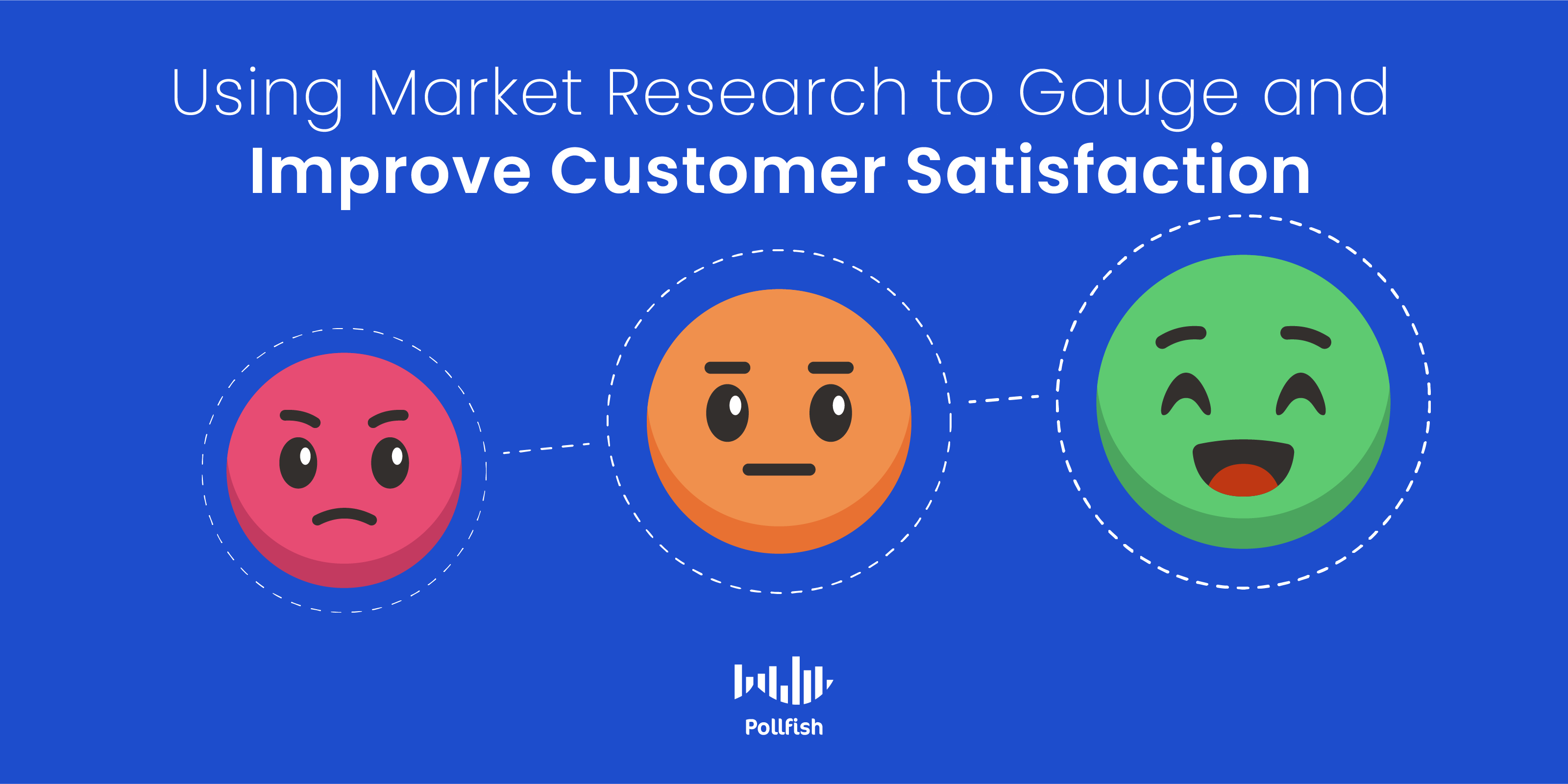
The importance of market research should not be glossed over by businesses, yet not all businesses apply it to their marketing efforts or even to their strategic planning process.
This missed opportunity has grave consequences for companies of all sizes; even large successful companies have lost billions in revenue from failing to conduct market research. Thus, all companies must conduct market research, whether they’re fledgling startups or long-established businesses.
This article expounds on the importance of market research so that businesses and researchers understand its value. It also shows how to conduct this kind of research to reach and maintain various business goals.
Defining Market Research
Market research is a specialized kind of research process; it refers to the organized methods by which an organization collects information about its target market and overall industry to inform its go-to-market gain continual intelligence on its industry at large.
Although used interchangeably with market analysis, they are not the same practice. Market analysis refers to the broader practice of studying a sector, industry or niche. This kind of analysis uses current and historical observations to make forecasts.
Market analysis primarily delves into existing business practices and products to plan for future business endeavors. Using raw data, market analysis gatherers a large supply of impersonal facts and figures. Thus this kind of research is far more general.
Make research, on the other hand, is more specialized in its design and approach, as it primarily focuses on examining a particular target market and its even more specific segments. Thus, it is far more customer-centric than market analysis.
Although the primary focus of market research is on a business’s customer base, it too involves elements of market analysis. Some market analysis projects in market research involve turning to secondary research as a means of understanding the broader environment of a market before narrowing the focus to its customer segments.
Market research can be conducted by amassing secondary resources or by conducting primary research. The latter may include using an in-house research team, which conducts market research techniques entirely on its own such as in field research, in exploratory research, experimental research or other methods.
It may also include an in-house research team that implements syndicated research or custom research. These refer to the external research methods of the receiving company, in which a market research provider conducts primary research for the business. In short, these two forms of research are a kind of outsourcing method for market research, as they represent services that extract customer data.
In syndicated research, a research project is funded by various companies and conducted by a research firm, which owns all the resulting data. Alternatively, custom research is a form of research in which a single business works with a market research provider on a project and funds it entirely on its own. Thus, the resulting data is also proprietary to the business.
The Importance of Market Research
The importance of market research is manifold. It provides various uses and can be used with multiple macro-applications and subsets of marketing, along with business needs as a whole.
The overarching umbrella of importance in market research is the ability to understand customers to the fullest extent, which includes: their needs, desires, opinions, frustrations, aversions, inclinations and other intelligence.
Understanding all of these factors in relation to a target market helps a business attract and retain customers. Both aspects are of utmost importance to a business, but customer retention is especially important, in that existing customers are far more likely to buy from a business.
In fact, the likelihood of selling to existing customers is 60% to 70%. Additionally, retained customers are 50% more likely to buy a business’s new product. Despite these figures which clearly illustrate the weight of customer retention, only 18% of businesses focus on customer acquisition, while 44% of businesses focus on customer retention.
Market research is also crucial for maintaining competitiveness. A business cannot thrive in a competitive landscape when it fails to do the necessary research to adapt to trends, new product/service upgrades and most importantly, customer needs. In fact, 9% of businesses lose their customers to their competitors when they don’t conduct market research to improve their customer loyalty and retention.
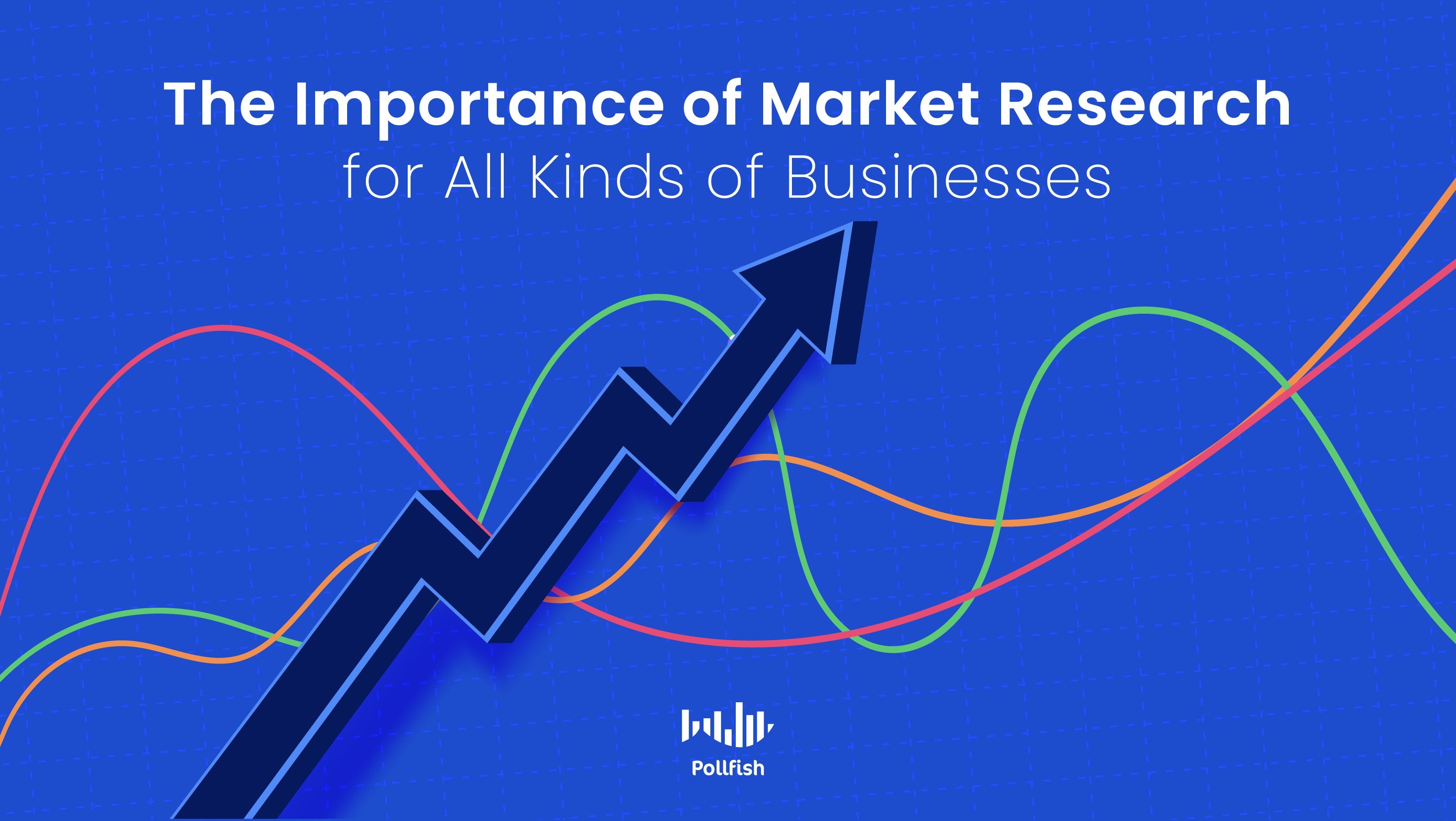
Market research helps businesses assess their customer satisfaction, whether they examine the satisfaction of existing customers or all those in their target market. As such, businesses can keep continuous tabs on customer preferences to understand how to better serve them, whether it is via products, services, customer support or digital experience (DX) across all digital channels.
Businesses can also learn customer sentiment in relation to the industry at large. This will help companies grasp their standing within their industries and in relation to their competition.
Moreover, conducting market research does not merely help businesses understand their customers' opinions and preferences. It also helps determine the exact makeup of a business’s target market via target market surveys and market segmentation. The latter identifies the subsets that make up a general target market, allowing brands to create granular messaging and campaigns to both acquire customers and retain them.
Furthermore, market research helps companies on the strategy side of a business, in that by studying their market and niche, they can devise critical documents and strategies to both launch a business, as well as propel it forward. For example, startups can use market research for business, while companies that have been in business for several years ought to use market research for their strategic planning process. The latter helps businesses map out their goals, better understand their ranking and establish practical objectives.
Finally, the customer-specific intelligence that businesses gain with market research helps support a variety of macro applications, from general marketing, to branding campaigns, to advertising projects, along with various studies such as longitudinal studies, cross-sectional studies, retrospective studies, prospective studies and others.
How to Conduct Market Research
There are many ways to conduct market research as there are various market research techniques. The two major classifications of market research are secondary and primary research.
Secondary research involves gathering and analyzing already available sources of customer data and other relevant information about a market. Secondary research can exist in a number of public resources, such as:
- Government resources: on government websites and databases
- Examples: The Census Bureau, The U.S. Small Business Administration, The Bureau of Economic Analysis and more
- Enterprise sources: trade associations, the Directory of Associations
- Research Associations: Composed of research analysts, they provide businesses with reports on specific subsectors of an industry.
- Examples: Forrester, Statista, Gartner, IBISWorldMintel: Market intelligence
- Industry blogs and content-oriented Websites: Online publications on the latest updates, trends and breaking news
- Examples: Ars Technica, The Business of Fashion, Grocery Drive, Realtor Magazine
- SEO and SEM Reporting: Tools for SEO (organic rankings efforts) and SEM (paid search)
- Examples: Ahrefs, SEMrush, etc.
Primary research refers to the various methods of amassing self-conducted research. Researchers can obtain primary research in a direct way, that is, by interviewing their target market themselves or by outsourcing.
Primary research methods include:
- Phone interviews
- In-store and in-person interviews
- Field research
- Mail-in surveys
- Focus groups
- Syndicated research
- The market research firm will be the proprietor of the extracted data
- An online survey platform
- The business is the sole owner of their extracted data
The following provides the steps that a business should take when conducting market research:

- Begin by conducting secondary research, which gives you insights into the broader market and niche. Use any of the above secondary sources, along with others.
- Look for information about the customers who belong in your target market.
- Find the patterns in your target market through the secondary sources. Keep an eye out for their demographics, psychographics, habits and behaviors.
- These will help you make hypotheses about your target market and how to best approach it for a number of campaigns.
- Next, conduct primary research via your method of choice. To do so, identify your most pressing curiosities from the secondary research you conducted.
- Tie your inquiries into a specific campaign or macro application.
- For example, do you need to conduct a longitudinal study to understand buying habits, or a study to test the effectiveness of ads?
- Conduct your primary studies with a set amount of participants.
- Surveys help you reach thousands of consumers in your target market.
- After you’ve gathered a significant amount of relevant information, perform an analysis.
- This ought to be done by more than one person within a business as different minds interpret data differently and can thus lead to different conclusions and ideas on moving forward.
- Then, ask yourself if your study is complete or you need additional data.
- If you opt for the latter, create another campaign and conduct further primary research.
- Analyze your primary data, along with your secondary data.
- Does the primary data align with the information you gathered from secondary sources? If so, it can point to repetitive behaviors or ongoing occurrences among customers.
- If not, consider the significance of the changes. Have the customers changed or has the industry changed which has led to the difference in findings.
- Additionally, primary research may not always align with secondary research, given that the business is at liberty to form its own questions and delve into its own curiosities and priorities.
- Draw conclusions and create a plan of action to reach your target market, whether it involves advertising, content strategy or any other campaign or change.
The Importance of a Strong Market Research Platform
In summary, market research is a crucial set of activities that businesses of all sizes and stages must conduct in order to better understand their industries and most importantly, their target market.
It identifies how customers view a business and allows businesses to identify and resolve gaps in customer expectations. As such, implementing a strong market research tool is an absolute must. While there are many market research tools, none are quite as potent in reaching thousands of people in a target market as online surveys.
Thus, a business should choose a robust online survey platform, one which makes it easy to design and deploy surveys, along with distributing surveys across a vast pool of digital properties. This will ensure that businesses have easy access to valuable customer data — the kind that approaches customers naturally in their digital environments, instead of being pre-recruited via email or survey panels.
Market Research Vs. User Research: Which Does Your Business Need?
Market Research Vs. User Research: Which Does Your Business Need?

Market research vs. user research: which is more important? This is the question many businesses must contend with. One thing is for certain; a business needs to conduct research in order to identify viable opportunities, latent threats and customer sentiments and needs.
In today’s age of evolving digital technologies, customer needs have also become more demanding — 63% of consumers expect businesses to know their needs and expectations, while 61% of customers have switched to a competitor after a bad customer service experience.
Businesses must therefore be discerning on the research they decide to use, whether it comes from in-house or external providers. Usually, combining both kinds is necessary in order to conduct both primary and secondary research.
Market research and user research apply both; additionally, both of them can be used within the 6 main types of research.
This article provides insights when facing the market research vs. user research debate so that you can determine the aptest kind of research for your business.
Defining Market Research
Market research is a term that encompasses several processes and methods for extracting information about a market. Specifically, it denotes the practice of collecting, analyzing, interpreting and consolidating data on your customers and industry at large.
This includes gathering data and information on your competitors, target market and your own products, services and experiences. As such, it refers to a holistic approach to gathering research for your business, as it relates to your business and its overall niches and industry.
Conducting market research is essential for understanding your target market — the segment of customers most likely to buy from you. Additionally, it allows you to make continuous improvements to keep up with changes in customer opinions, attitudes, behaviors and demands.
Aside from enlightening your business on its CX, market research allows you to understand the inner workings of your entire field, from your direct competitors to those not within your niche, to innovations and much more.
The Importance of Conducting Market Research
Performing market research is crucial for businesses big and small, for the reasons stated above and several others. First off, market research entails gathering secondary data from virtually all sources that pertain to your business and its encompassing industry.
From checking your competitors’ digital properties to keeping tabs on their ads and social media, along with turning to trade publications, news, statistics and market research websites, it allows you to stay informed on all the ins and outs of your industry.
Then, there’s the customer side. Market research ensures a satisfying and friction-free customer experience by studying the concerns of your customers. This goes beyond studying secondary source trends and statistics.
Instead, primary research is a large component of the process. By conducting a consumer survey, interviews, focus groups, field research or running experimental research, you will gain a deep understanding of your customers. There are other methods of performing primary research, all of which fall under market research.

By studying your customers, you gain the imperative knowledge for catering to them, along with steering clear of their aversions. As such, you can avoid issues that tarnish your brand’s reputation along with those that trigger customers to patronize your competitors.
You can also run market research campaigns on your own products and services, to see how your target market truly feels about you. This practice can also help you discover what’s missing in your industry, allowing you to innovate more quickly.
Continuously running market research campaigns will thus guarantee you stay well-informed on all the concerns, needs and opportunities of your business and the overall market.
The Pros and Cons of Market Research
While invaluable for businesses who wish to not merely stay afloat but to become and remain competitive, market research also carries a few drawbacks. Businesses and researchers ought to be aware of both the benefits and pitfalls of market research.
The Pros
- Allows you to stay abreast of all changes, behaviors and innovations within your industry.
- Enables you to conduct market segmentation to discover the segments making up your target market.
- Grants you insight into all of your target markets’ needs, attitudes, aversions and sentiments.
- Helps you brainstorm and strategize more effectively, as you are equipped with data.
- Limits risks and liabilities.
- Propels higher sales.
- Measures viability of new products and services.
- Helps you find the gaps and limits in your industry, ideal for creating new products and offerings.
- Finds new markets and niches you can explore and eventually serve.
- Supports all decision-making processes.
The Cons
- The total sum of all the research that makes up market research can be expensive.
- It forms a long and winding process, which can make certain campaigns feel boundless.
- It requires keeping track of ongoing changes, as such, certain sources may not be as relevant and accurate of the industry.
- There are biases present in many sources of information:
- Primary research: survey bias, lack of field research to form conclusions, dishonest interviews, etc.
- Secondary research: biases in secondary publications, outdated content rebranded as new (via date changes but no updates)
Defining User Research
User research comprises far more than usability testing. Also called design research, user research aims to study the users at the center of the design process of your products and experiences. As such, it involves examining the various needs, concerns and pain points of your target users.
This kind of research is primarily useful for product designers and experienced producers, who use the insights from user research to make educated decisions for decisions. With this form of research, designers avoid or reduce product glitches, gaps and producing things with scant market demand.
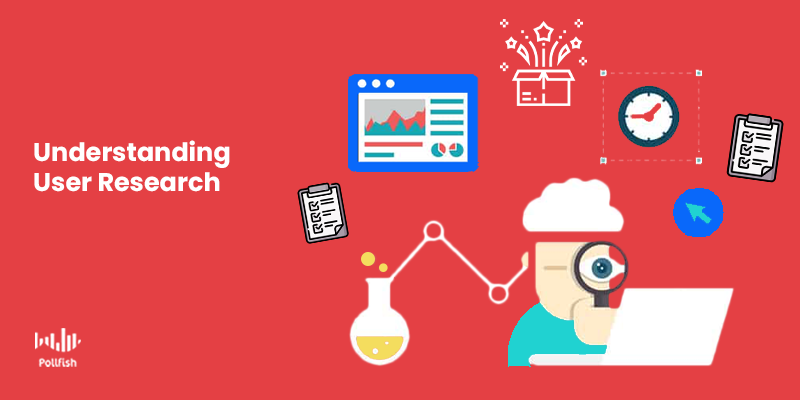
Like market research, it relies on a wide range of methods and processes in order to gain the information the designers and product managers seek. The various components that form user research can thus be used to discover design opportunities and crucial information to guide the design process.
User research involves conducting ethnographic studies via interviews or performing user testing, quantitative research on the ROI of your products and UX designs and surveying your target market. The latter involves a wide range of topics, such as existing product satisfaction surveys, surveys on your product ideas, surveys on competitor products and many more.
Other user research methods and tactics include:
- Accessibility evaluations to ensure an inclusive design of your product.
- Studying customer journey maps, essential to understanding your customer journeys, is a major aspect of digital CX (customer experience) or UX.
- Studying website analytics to understand traffic, bounce rates and other metrics to learn which content engages and which requires improvement.
- Evaluate information architecture via card sorting so that you assure your design is structured logically.
- Conducting contextual inquiries via field research (in-store observations, observing product testers) and digital observations (chats, a customer experience survey)
The Importance of Conducting User Research
User research is of the utmost importance when it comes to design strategy, as it functions as a foundation for it, along with a continuous source of insights to strengthen it. It equips project managers, designers, markets and business owners themselves with key data to buttress your design ideas and decisions.
This kind of research allows you to pinpoint the best candidates for using your product, as well as the members of your market segments who would be most likely to engage with a digital asset. In turn, this aids your marketing strategy, as you’ll understand which segments to target in your marketing efforts.
User research can foster this activity, as creating a successful marketing strategy relies on avoiding the mistake of marketing to everyone. As such, you cannot target all the segments of your target market in the same way. You’ll need to create different messaging for each segment, some of which require marketing entirely different products and experiences.
User research thus forms the bedrock of a productive marketing strategy.
Moreover, user research forms the basis of a product-design cycle. While you may be confident in a product idea, design, or upgrade, it is useless if no one else has a need for it or finds it difficult to use. Thus, user research assures that there is both demand and, as its name implies, usability, within your product.
It avoids the further design, planning, development and expenditure of resources on an unwanted or faulty product or experience idea.
It also grants you insights into who the users themselves are, the context in which they’ll use your product or experience and the problem your product/experience solves. Additionally, it helps you understand all of their needs from your business, especially in relation to products and experiences.
Essentially, product success hinges on user research.
The Pros and Cons of User Research
While necessary to conduct, user research presents several deficiencies as well. Researchers and business owners should comb through both the advantages and pitfalls of user research before they set out on conducting it.
The Pros
- Without UX research, your design is left with nothing but assumptions and intuitions.
- Forms the initial steps of producing an entirely new product/experience or innovating on an existing one.
- Contextualizes the use of your products, such as the environments they are used in and the problems they help solve.
- Gives you deeper insights into your site users and customers.
- Ensures you create products that your target market desires.
- Helps you avoid usability issues and glitches.
- Saves you both time and money on flawed products or those that your target market doesn’t need.
- Allows you to understand what your users don’t use your products/experiences for.
- Ensures you evaluate your design with data reflecting the needs and behaviors of your users.
- Lets you understand the impact of your design on your target market.
The Cons
- Users don’t always remember everything they do and use a product for.
- User research data is complex and thus requires plenty of time to conduct, consolidate and analyze.
- The risk of researching the wrong audience, as survey respondents and other study participants may be dishonest about using a particular product or experience.
- Confidentiality is not assured, as users may share screenshots of your products for competitors to see. This occurs in user testing and experimental research.
Market Research Vs User Research Faceoff
Aside from delving into the key specifics and of these two forms of research, the needs they help fill along with their flaws, it is useful to understand the key facts that separate them. The following graph shows the key differentiators between these forms of research.
| Market Research | User Research | |
| Focus | Customers, products and the market at large | Product needs, usage |
| Key components | demographic, behavioral, economic, and statistical information | Information on product needs, fits, uses, user movements, mechanisms |
| Sample size | Larger | Smaller |
| Representativity | High | Low |
| Theme | What people buy | How people use a product |
| Insights | Touch upon broader topics | Deeper insights on fewer topics |
| Quantitative/ Qualitative | Both | qualitative |
| Goal | Measure industry needs and trends, customers and competitors to release viable offerings | Measure and improve the user experience |
Which Method Does Your Business Need?
Market research vs. user research may appear to be something of a showdown, a battle in which only one form of research must be chosen. But when it comes to conducting either form of research, there is no battle or face-off.
Not to be anticlimactic but there is no winner in this “showdown” — which is not to say you’ll need all the types of research available, as aforementioned in the introduction. For example, some businesses may require correlational research, while some may only require causal research.
However, when it comes to market research vs. user research, there is no either-or. All businesses, even B2B businesses must conduct both forms of research.
This is due to various reasons.
Concerning the latter, there is a lot of overlap in these forms of research. For example, both heavily rely on using surveys to reap key insights from a target market. Both also involve studying the product and user experience. Both involve carrying out primary and secondary research.
As for the latter, although a B2B business may not offer any products, it will always rely on digital customer experience. It is virtually impossible to exist as a B2B business — or virtually any kind — without a website. Many such businesses also invest in social media and content marketing. As such, they’ll need to understand user experiences.
In summary, businesses can achieve success by conducting both market research and user research; the two exist hand in hand, with one buttressing the other. A strong online survey platform can plan, support and fully execute both kinds of research. As such, you’ll need to choose an online survey provider wisely.
The Complete Guide to Market Research Techniques
The Complete Guide to Market Research Techniques
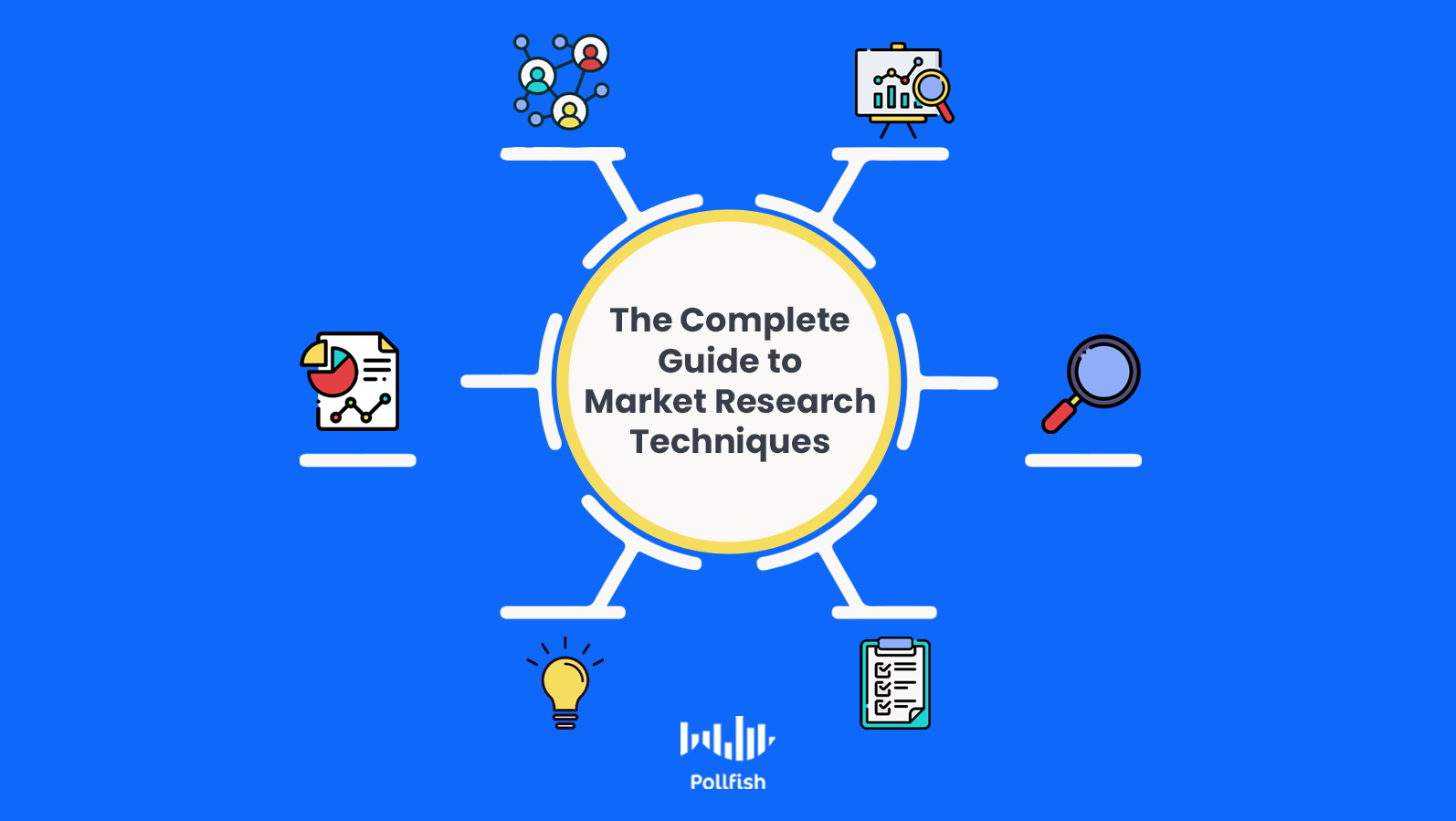
If you intend to conduct market research, you'll need to be well versed in market research techniques. These methods will help you carry out a sufficient market research campaign, allowing you to better serve your customers and steer your business toward.
But when you are facing a concept as broad as market research, it is rather challenging to know where to begin and how to conduct the various forms of research.
This complete guide to market research techniques will help lessen this challenge so that you can stride confidently into all your research needs.
Defining Market Research
Like several aspects of business, market research is not bound by one concept; rather it is an umbrella term that encompasses a wide array of practices.
Market research is the process of gathering information about your target market (the people most willing and likely to buy from a business), segmenting your buyer personas (market segmentation) and amassing knowledge on your competitors.
This category of research allows businesses to gain insights into the quantifiable aspects of their industry, along with the opinions and attitudes of past, current, potential and churned customers.
The ultimate end goal of market research is to learn how successful your product or service is and/or will be within your industry, niche and most importantly, within your target market.
Primary Vs Secondary Research Research
The chief divider of market research involves the method of researcher participation, aka, the way the research is conducted.
Primary research denotes an active form of research, in that researchers conduct the research themselves. This signifies that the information they are seeking has not yet been collected, or, that the research they need has been gathered, but they seek to gain their own, firsthand data.
As such, primary research involves using primary data, that is, the data that a researcher would extract themselves.
On the contrary, secondary research entails research that has already been conducted and (usually) has been made available. With this research category, the researchers aren’t required to amass their own intelligence; rather it involves aggregating knowledge that has already been collected and passed on by others.
As such, this kind of research largely involves summarizing, synthesizing and scrutinizing data and other forms of intelligence. Secondary research often involves studying the primary research that others have already conducted and packaged in their chosen form.
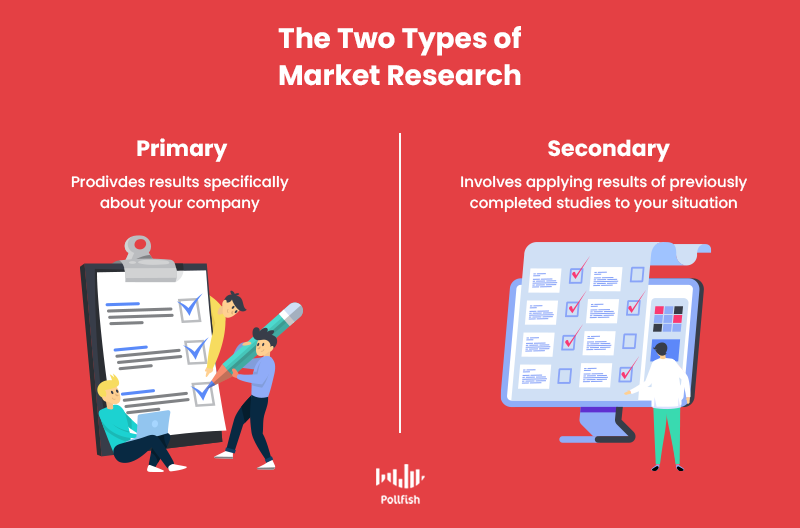
It is important to incorporate both styles of research for a comprehensive market research campaign. This is because there are going to be subjects that you cannot study simply through one form of research. For example, your competitors aren’t going to publish the primary studies that depict them in a negative light, no matter how accurate they are.
Another example is your own set of customers; secondary research alone is not going to provide an adequate amount of data on them. There may not even be any data on your particular customer segment.
Primary Market Research Techniques
Here are a few techniques for completing primary market research. Researchers need not attempt all of these techniques, as some will be more useful and easier to execute than others. It all depends on your preferences and goals.
- Interviews: One of the more intimate methods, interviews can be managed over the phone or in person.
- Focus Groups: A more interactive form of interviews, this technique gathers data from a group of about 6-10 participants. Focus groups study subject matter experts. Using a moderator, these groups aim to incite discussion among the participants. This is a good method to perform to learn about a specific segment of your target market. Focus groups rely on open-ended, broad and qualitative research questions.
- Field Research: This is an observational method on subjects in their natural environment. To use this method, researchers do not interfere with the outcome or behavior of a situation. This technique grants direct observation of people and their interactions. Ex: An electronics brand seeks to observe how customers interact with a new line of products. They may do field research on in-store customers to study this.
- Surveys: Online surveys are the best distribution method and allow you to study any topic. A strong online survey tool will enable you to set granular demographics requirements, ask a wide style of questions (multiple-selection, single selection, ratings, etc), add advanced skip logic, add media files and use multiple audiences per survey. Surveys can take many forms; business and consumer surveys alone form macro surveys that include their own survey types.
- Test Marketing: This technique involves testing the usage and opinions of a new product by selling it to a small segment of one’s target market. For example, software brands test-market by using the “beta” versions of new features/products on a small group of likely customers. This method helps predict how a new product will fare in a larger market.
Secondary Market Research Techniques
Secondary market research techniques require using sources specific to your industry and niche. While some sources may be general, you’ll need to gather intelligence most pertinent to your target market — or at least your industry. Here are a few citations to use for secondary research.
- Government Resources: The government collates massive data on citizens; this data is free and can be found on a number of government websites.
- The Census Bureau: Provides a portrait of the American economy, market sizes, populations, demographics and more. It includes the American FactFinder tool, which finds demographic, economic, social, household, and other data on geographic regions.
- The U.S. Small Business Administration: Captures statistics on economic matters such as employment, salary, income, sales and more. The SizeUp tool allows businesses to compare themselves against competitors.
- The U.S Department of Commerce: With offices scattered across the US, the U.S. Department of Commerce generates data on industries and their products and services.
- The Bureau of Economic Analysis, which is a part of this department, creates economic reports on income, expenditures, and even savings data on a quarterly basis. This site shows the trends in product/service demand based on spending.
- Enterprise Sources: These resources are not free, but offer invaluable insight into particular trades and subsectors.
- Trade Associations: Perfect for studying your industry, they’re made up of groups of businesses that cater to specific subsectors. Use the following to find your industry association.
- Research Associations: Composed of research analysts, these associations to be independent, although some are affiliated with trade associations. These organizations provide businesses with granular reports on specific subsectors of an industry. They include:
- Forrester: Research in the consumer business and tech sectors.
- Statista: Statistics, reports, infographics & more on 170 industries and 150+ countries.
- Gartner: Research for senior leaders with business insights, advice and tools.
- IBISWorld: Industry reports by sector and country.
- Mintel: Market intelligence across industries and countries.
- Dun & Bradstreet: Data, analytics, and commercial insights for businesses with 120 million business records on over 1,000 industries.
- Industry Blogs and Content-Oriented Websites: Each industry has online publications dedicated to reporting on them. These are useful for the latest updates, trends and breaking news, the kind that a major report or downloadable asset may not provide. Here are a few examples across different industries.
- Ars Technica: A website covering news and commentary on the technology, science and politics space.
- The Business of Fashion: News and intelligence on the fashion industry.
- Grocery Drive: News that focuses on the grocery and ecommerce spaces.
- Premium Beauty News: Markets, trends, laws, new products and other news within the cosmetics industry worldwide.
- Realtor Magazine: News surrounding the real estate industry.
- Educational Institutions: Colleges and universities have research departments that study a wide range of business data. These insights are not free but involve heavy-duty market research from faculty and students. They include:
- Graduate student projects
- Faculty-based projects
- SEO and SEM Reporting: SEO is critical to growing your business online, as your target market won’t purchase from your business if they don’t find it. SEO/SEM sites help you gather keyword research to learn the most relevant to your niche.
- SEMrush: For SEO, PPC, content, social media and competitive research.
- Moz: For rankings, keywords and link testing.
- ahrefs: For rankings, site audits and keywords.
- Google Keyword Planner: For finding keywords, tied with Google Ads.
- Screaming Frog: A site crawler for technical SEO site audits.
Quantitative Research vs Qualitative Research
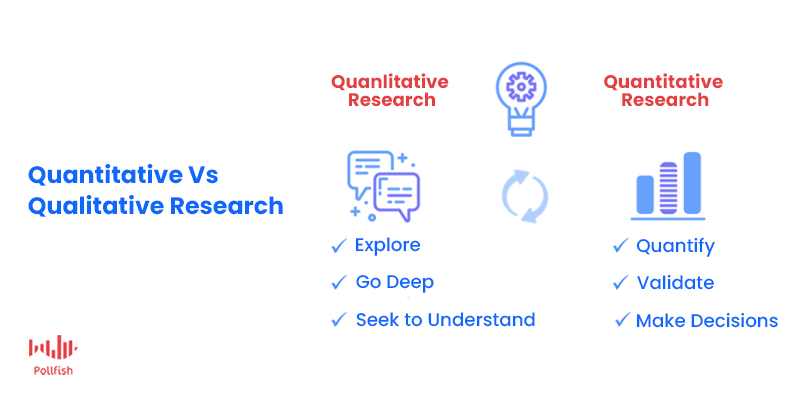 Another crucial market research division is that of quantitative and qualitative research. Unlike primary and secondary research, which can exist without one another, quantitative and qualitative research are used in complementation.
Another crucial market research division is that of quantitative and qualitative research. Unlike primary and secondary research, which can exist without one another, quantitative and qualitative research are used in complementation.
This means you would often use both in your research campaigns.
Quantitative research is marked by measurable data that quantifies the opinions, attitudes and experiences that respondents report. It collects numerical data for producing statistics, finding prevalence and identifying patterns.
The goal of quantitative research is to test a theory or hypothesis. Another common objective is to measure opinions in regards to a particular research topic. Quantitative research is also used to find causal relationships between variables, predict outcomes and create generalizations on broad populations.
Computing an instance or phenomenon takes precedence in this form of research, rather than gathering the reasons and motivations behind it. This kind of research works out the “who” and “what,” of a research subject.
Qualitative research stands in contrast with quantitative research, as a descriptive form of research. This form of research inquires into the depths of an attitude, opinion or phenomenon. Instead of delving into the statistical aspects around a research subject, which is known as the “what,” it works to find the reasoning behind it.
As such, this research doesn’t seek to describe a situation, opinion or occurrence; rather it focuses on establishing the “why” behind it.
Qualitative research was designed to take place in natural environments, i.e., places in which research participants can provide thorough answers. This environment can take place on or offline.
This form of research relies on using psychological, ethnographic and sociological approaches to study a target market. The design of a qualitative study evolves (along with the participants it studies).
In this form of research, there is no such thing as a single reality; rather it is changeable and subjective. It is highly interpretive, as it doesn't involve simply adding or crunching numbers.
Quantitative Market Research Techniques
Quantitative research involves using methods that collate measurable data that can be encapsulated in graphs, charts, tables and other visualizations. Here are a few techniques for gathering this kind of data:
- Experiments: Researchers can conduct experiments on products, such as producing beta versions, as tech companies do. They can also do A/B testing on digital experiences such as digital ads, emails and even on-site experiences. Additionally, researchers can run experiments in-store to test customer satisfaction with employee service and product layouts.

- Observations: Part of field research (as mentioned under primary research), researchers can observe customer behavior and occurrences in natural environments such as in-store behaviors. Observations can also exist online, for example, by using session replay tools found in analytics software.
- Statistics and other Published Resources: Researchers can garner quantitative data by studying secondary research. The technique involves looking at statistics websites, along with other data sources such as infographics and reports. This is a good starting point when dealing with quantitative data; it can also be used to compare findings between past and present data.
- Surveys: Perfect for discovering the “what” with multiple choice and multiple selection questions. Matrix questions help find the intensity of a phenomenon. There are swaths of different survey types you can implement, including macro ones like business surveys and consumer surveys, along with specific surveys such as the Net Promoter Score (NPS) survey or the Employee Satisfaction Survey.
Qualitative Market Research Techniques
Quantitative research techniques necessitate being able to understand opinions in more depth to uncover motivations, reasonings and consumers’ general psyche. These methods do not require quantifying any findings. Instead, they require using exploratory and open-ended questions; the kind that fully reveal the bedrock of consumers’ attitudes.
Here are a few techniques:
- Focus groups: These spur natural discussions by incorporating a small group of people with a moderator who prompts various conversations. Focus groups consist of people who share demographic attributes to study a target market or a segment of it. Unlike interviews, which are one-on-one, focus groups allow multiple people to speak, mimicking natural discourse and therefore having the participants influence each other.
- Unstructured interviews: Unstructured interviews are in-depth interviews in which there are no premeditated questions. Instead, the interviewer asks open-ended questions that relate to the research topic. This way, the conversation runs like a natural exchange. The interviewer would keep questions relevant to both the research topic and the participant’s experiences.
- Textual and visual analyses: A form of secondary research, researchers can draw analyses from qualitative research documents already available. This including looking at trade publications or research publications that focus on various consumers and other demographics.
- Case Studies: This technique uses thorough investigations on a participant, a group, an event or a community. It merges various sources such as interviews, observations and surveys. Researchers analyze the data from these sources and put together the case study document. This is used in clinical medicine, but can be applied to numerous other industries, including the general business vertical. This method uses both information from the past (retrospective) along with present and everyday manners.
- Surveys: Surveys can be every bit as qualitative as they are quantitative. In a qualitative survey, you would use open-ended questions. These often dovetail to quantitative questions by going more in-depth on them. Thus, you would need to use skip logic, so that if a respondent replies in one way, they would get rerouted to the appropriate follow-up question. Like with quantitative surveys, qualitative surveys can be applied to macro concepts like in cross-sectional surveys or for more specific ones, such as with community feedback surveys.
Other Forms of Market Research Techniques
Aside from the above two major types of market research classifications, there are several other major kinds of research techniques. Here are a few vital examples:
Retrospective Research
This research studies past events to see if or how they contributed to a current topic of interest. Also called historical research, this study inspects historical data. It falls under cohort studies, which follow a group of participants bound by a similar trait. This research uses observational studies that determine how often a phenomenon occurs within a targeted population. Techniques include:
- Survey panels
- Longitudinal surveys
- Interviews
Cross-Sectional Research
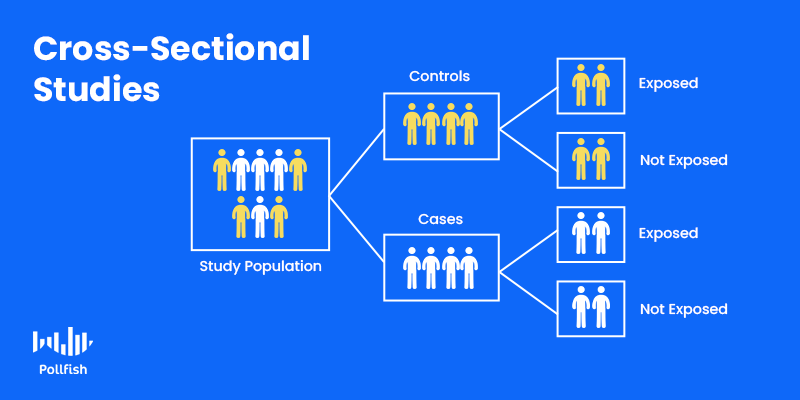
A cross-sectional study collects research on a particular population at one fixed point in time, essentially serving as a snapshot (aka cross-section) of a studied population. This type of survey does not require using a survey panel as this method follows a panel over several points in time. It is contrary to longitudinal studies, since they study participants at ongoing frequencies. Instead, it seeks to gain an overall portrait of a phenomenon during its time of study. Techniques include:
- Field research (especially recent studies)
- Interviews
- Surveys (Ex: community feedback surveys)
Prospective Research
Prospective research aims to predict the likelihood of a future event or issue. It is focused on outcomes and can also determine relationships between variables. A prospective study usually involves investigating a cohort of subjects over a long period. This research tends to be experimental in nature, as it seeks to uncover relationships between variables. Techniques include:
- Experiments
- Trials
- Longitudinal Surveys
- Focus groups
- Survey panels
Wading the Waters of Market Research
While this guide covers the most pertinent and useful forms of market research technique, there are still more to explore. That is because certain techniques, such as survey research methods have many forms and subsets of methods that brands can apply to their campaigns. A strong research campaign will guide you deeper into the many techniques available, some are tried and true, while others are newer.
When you fortify your secondary research with a strong primary research tool, your campaign will be on the right track towards unique insights for all your business and market research needs.
Diving Into Longitudinal Surveys
Diving Into Longitudinal Surveys

Longitudinal surveys are the most powerful assets that marketers and market researchers can use when conducting longitudinal research.
We’ve previously highlighted the three main types of survey research methods, which include cross-sectional studies, longitudinal studies and retrospective studies. In this article, we will cover longitudinal surveys and their underlying studies.
You can apply longitudinal studies for a wide range of verticals and purposes. As such, it is crucial to learn about this research method so that you can set it off smoothly for your survey research needs.
Defining Longitudinal Surveys
A longitudinal study is defined as a study in which researchers gather data on the same set of variables (respondents) over a period of time. This kind of research grants researchers the ability to closely examine the trajectories and changes of their subjects over time.
This study includes gathering insights on the sample pool’s opinions, behaviors, sentiments, desires, reactions and several other aspects. Mostly used in medical and social sciences, this form of research is also invaluable for brands, as studying your target market is key to keeping your business alive.
A form of correlational research, researchers (and businesses) conduct longitudinal research via collecting data on a group of variables without influencing or affecting the variables in any way. Each data collection is called a wave.
It is optimal to conduct this kind of study via longitudinal surveys, as they are designed to garner all the questions you need and to create them in innovative ways.
The Key Aspects of Longitudinal Surveys
To fully understand longitudinal surveys, you should peruse some of their key features. This will help you understand their make up and decide whether to use them for your survey research.
The following lists the core facets that distinguish these surveys from that of others. Here is how they differ aside from their deployment frequency:
- These studies and their surveys gather insights over long-term periods.
- Despite being typically used for a long period of time, there is no fixed amount of time required to constitute a longitudinal study.
- These studies can range from several weeks to years and even decades.
- They are part of observational studies, in which no intervention takes place, only pure investigation.
- They involve repeated observations of the same group of participants.
- They are used to uncover relationships between variables that are not connected to background variables.
- They are used to discover how the sampling pool (respondents) changes over time.
- They are used after extracting some findings from cross-sectional studies, when those studies warrant more data and inquiry.
- They collect both quantitative and qualitative data.
- They can be conducted through primary research, along with secondary research.
- Primary sources: surveys, survey panels, interviews, focus groups
- Secondary sources: government websites, focused reports, ex: longitudinal studies on American youth
How They Differ from Cross-Sectional & Retrospective Surveys

Longitudinal studies are often contrasted with cross-sectional studies. They also differ from retrospective studies. The survey of each study follows suit, as it will be distinguished in design, function and deployment frequency.
Unlike longitudinal studies, cross-sectional studies involve examining samples of a given population (the cross-section) at a particular point in time. The surveys in this research method paint a snapshot of a sampling pool, usually the prevailing one.
As such, cross-sectional studies are far shorter to conduct. They are often used as precursors to longitudinal studies, in that they discover correlations that can be further probed longitudinally.
Retrospective studies combine aspects of both cross-sectional and longitudinal studies. They study respondents with surveys about past events. Researchers can thus compare past feelings and attitudes with those of the present, much like in longitudinal studies. In this way, these studies are used hand in hand with longitudinal studies, despite that retrospective studies form their own distinct set of research.
Retrospective surveys can be conducted just once, as are cross-sectional surveys. They may also amass data on several points in time. These surveys draw from a pool of an already existing data set.
As such, retrospective studies only deal with events of the past and will not gather any new data; that’s where longitudinal studies are needed to be used in tandem with them.
It’s important to note that all three of these research methods/survey types are observational, allowing researchers to record and understand the subjects’ behaviors via observation only.
The 3 Types of Longitudinal Surveys
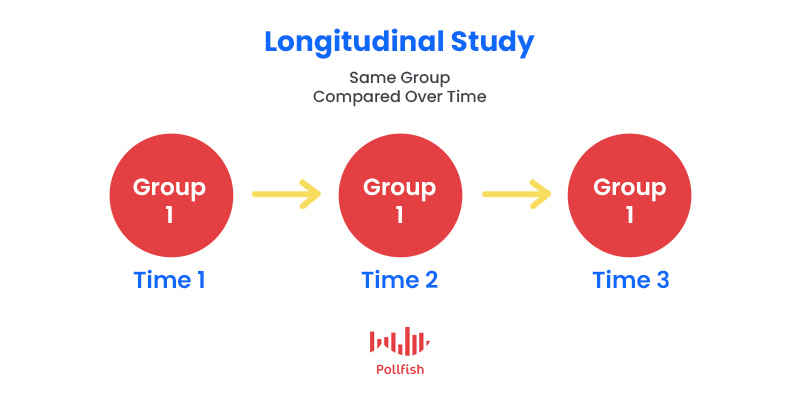
Longitudinal studies can be carried out in various ways. There are three main classifications of longitudinal surveys: a panel study, a cohort study and a retrospective study. As mentioned above, retrospective studies make up their own major form of research. However, due to their close involvement with longitudinal studies, they can also exist as a form of these studies.
Panel study:
- It involves sampling a prerecruited set of survey respondents.
- These respondents agree to a particular length of participation.
- Surveys are sent to the exact same group of respondents.
Cohort study:
- It is conducted through online survey software.
- Respondent selection is set by way of shared characteristics, such as a geographical location, births and historical experiences.
- It also deals with respondents on the basis of demographics and opinions and behaviors (the latter two are collected via screening questions).
Retrospective study:
- It uses past information on the same or similar subjects (variables).
- It involves studying the past with recorded data. Ex: medical records, past surveys.
- It complements any current or soon-to-be gathered longitudinal data.
The first two types of surveys are part of prospective longitudinal research, in which a sampling pool is studied over a period of time. They therefore fall opposite to retrospective studies.
Which Industries Depend on these Surveys for Market Research
There are several industries that utilize longitudinal surveys for market research undertakings. These surveys, therefore, provide a wide variety of applications. The following list details the various verticals that rely on longitudinal surveys.
- Healthcare: Physicians, other healthcare providers and researchers can study any biological change in participants in terms of their lifestyle, i.e., their diets, their fitness/ sedentary habits, health upkeep, reactions to medicines and much more.
- Retail: Retailers can study shopping habits from time to time and discover how advancements in the sectors affect those habits or form new ones.
- Psychology: Psychologists can conduct these surveys to study how the mentality and psyche of various groups change over time in reaction to stimuli or any change.
- Education: Those in the education sector can use students' test scores, work and products to track developments over time. Monitoring student progress can also identify disparities in academic performance levels among students.
- Real estate: Real estate agents and business owners can use these surveys to gather opinions of residents and businesses within a neighborhood or property over time.
- Technology: Tech leaders and manufacturers can learn how consumers change or develop certain behaviors due to the use of existing technology or the emergence of new kinds.
- General business: Brands can conduct these surveys to closely monitor their target market, especially in relation to their products. Additionally, businesses can study closely associated target markets or even different knees to gain new patrons.
Types of Business Surveys that Rely on Longitudinal Studies
Dovetailing onto the final industry using longitudinal data, that of general business, it is crucial to understand just the kinds of surveys that brands can use. This is because a wide array of survey types (based on the subdisciplines of business) can be applied in longitudinal studies. Here are a few key survey types:
- Marketing market research: Brands can use marketing surveys for market research to study trends in the market and within niches firsthand. They can also help businesses capture demand for their product/service, along with measuring campaign success.
- Customer Satisfaction: A major component of any business, there are a variety of surveys for this purpose, such as the Net Promoter Score (NPS), Customer Satisfaction Score (CSAT) and the Customer Effort Score (CES).
- Product feedback: These surveys provide necessary insight into the sentiment around product launches or existing products, should you want to test their levels of customer contentment. You can test for usability, awareness and general opinions on your products via longitudinal feedback.
- Employee engagement: Not all survey research is external, not even when it comes to the longitudinal variety. As such, it is apt for businesses to keep an eye on their employee engagement levels. This involves checking on employees’ comfort on the job and collaboration with others. A longitudinal survey on employee engagement will give you the full scope of your company’s pulse and how to improve it.
The Pros and Cons of Longitudinal Surveys
Longitudinal studies, like others, come with their own sets of benefits and stumbling blocks. You ought to consider both sides in order to get the full picture on this kind of research method. Understanding the pros and cons will help you determine whether it is worth using this kind of study and its accompanying survey(s). It will also keep you aware of what to expect.
Pros
- Longitudinal surveys allow you to monitor your target market and general sampling pool in real time. This allows you to place all insights sequentially and be able to correlate events with causes.
- This is the only study that gives you access into observing developments and life-spanning issues.
- These surveys allow you to study hypotheses conjectured at cross-sectional surveys to learn more and form educated decisions.
- This is the most optimal study for identifying causal relationships and cause and effect.
- It stamps out the risk of recall bias, which denotes the inability to remember past occurrences.
- It can be used within a variety of survey types and industries including ones not mentioned above such as advertising, community feedback and more.
- They allow you to discover which sentiments and behaviors are conditional and which withstand the test of time.
Cons
- These are the most time-consuming surveys; they may not work alongside other surveys since they’re results aren’t complete until the end of the studied period.
- They require the most resources and are the most expensive kind of survey to conduct.
- Respondents may drop off over time, as not all are going to be as committed to the study. This is known as selective attrition.
Beyond Market Research: Longitudinal Studies as Content Assets
Longitudinal studies take the most amount of dedication and commitment — both on the end of the researchers and respondents due to their time-consuming nature. Nonetheless, they are valuable sources of primary research.
For businesses, these kinds of surveys do far more than just provide firsthand insights and data. Marketing teams can delight in that conducting longitudinal studies provides an invaluable content marketing asset, the kind that will easily distinguish a brand from its competitors.
Many businesses rely on content to increase brand awareness and gain leads. In fact, 60% of marketers produce one piece of content per day to grow their business. There are brands that use it to boost their user experience (UX) and even retain their customers. While blogs and social posts are typical, a longitudinal study is a downloadable asset worth conducting. It may be enlightening enough to gain media attention.
Frequently asked questions
What are the three main types of survey research methods?
The three main types of survey research methods are longitudinal studies, cross-sectional studies, and retrospective studies.
Why are longitudinal surveys performed?
A longitudinal survey is one that is created in order to gather data from respondents over a period of time. Surveys are distributed multiple times to the same group of respondents in order to study how specific variables change over time.
Why are longitudinal surveys performed?
The purpose of a longitudinal survey is to understand how a group’s behaviors, opinions, feelings, needs, and desires change over a period of time.
How does a longitudinal study differ from a cross-sectional study?
Cross-sectional studies provide a snapshot of the sample pool at a specific point in time, while longitudinal studies provide many snapshots of the sample pool at specific points over a period of time.
What are the three types of longitudinal studies?
The three types of longitudinal studies are panel studies, cohort studies, and retrospective studies.
How Market Research Can Build Consumer Loyalty
How Market Research Can Build Consumer Loyalty

Consumer loyalty is the principal objective of any business, a purpose more that should be more sought after than sales alone. This is because consumer loyalty is the main driver behind repeat sales.
This end cannot be reached overnight and to the surprise of many brands, it cannot be reached simply with a quality product. Instead, it takes several factors to build consumer loyalty.
This article explores consumer loyalty, why it is crucial, how it can benefit your business and mainly, how market research can help you achieve it.
Defining Consumer Loyalty
Consumer loyalty can be defined in several ways, some are more specific than others. While it may sound self-explanatory, for the purposes of market research, this concept is specifically defined as: the measure of a customer’s likelihood to patronize a business repeatedly.
As the name suggests, this phenomenon stems from a feeling of loyalty to a brand, the kind that chiefly results from product satisfaction, customer satisfaction, and a good customer experience (CX). However, there are many other aspects that play a role in consumer loyalty.
These can be difficult to obtain as brands cannot fulfill all of their customers’ wishes. They certainly cannot achieve this feat if they do not know all of their customers’ pains, needs and concerns.
This is where market research comes into play. You can conduct market research in a number of ways.
What Brands Gain from Consumer Loyalty
The goal of consumer loyalty is crucial to obtain and not just for the evident reasons. There are key facts on consumer loyalty that bear statistical importance. As such, brands need to approach this topic seriously.
Firstly, customer Loyalty is the main contribution to customer retention. A mere 5% increase in retention raises profits by 25-95%. This is not only because retained customers make repeat purchases, but also because repeat customers spend more money.
Consumer loyalty breeds brand ambassadors, and 83% of consumers will recommend a brand they are loyal to.
Aside from these statics of customer loyalty gains, you ought to know how customer acquisition — the act of gaining new customers measures up to customer loyalty. While acquiring new customers is key to business growth, customer loyalty still reigns supreme in comparison. This is because:
- Acquiring new customers costs about five times more than retaining existing customers.
- Selling to loyal customers has a 60-70% success rate, while selling to new ones has a 5-20% success rate.
How to Build Customer Loyalty with Market Research
Market research is an umbrella term that covers various methodologies to determine the success of a new product or service through researching one’s target market, competitors and the general state of an industry.
By examining your target market, i.e., customer base, you can learn about its preferences, needs and pain points. Tapping into the minds of your target market will allow you to serve them best, whether it is through new products, product upgrades, online experiences or general CX (customer experience).
Market research involves using primary and secondary research, that is, self-conducted research and research that has already been conducted and made available, respectively. The following delineates the attributes that foster customer loyalty, along with how market research can build them up.
- Usability: Customers need to be reassured of the usability of your products/services. Understanding the ease of use of your offerings is thus crucial to creating customer loyalty. Primary research such as focus groups and surveys reveal the degree of your business’s usability, paving the way for understanding what works and what doesn’t.
- Trust: If customers don’t trust your brand for any reason, they will not return for future transactions. To test how you fare with your customers, conducting customer satisfaction surveys, Net Promoter Score (NPS) surveys and other customer loyalty surveys. To get a sense of how customers generally view brands in your niche, you can use secondary research like statistics sites, industry reports and blogs in your industry.
- Customer Service: A key part of UX, customer service involves any touchpoint in which customers interact with company representatives. This includes leads speaking with sales representatives over the phone, a customer relying on a cashier or sales associate for help in-store, chatting with a rep via a site’s chat or getting phone support. You can use secondary research to get an overview of customer service in your industry via industry sites. You can also conduct secondary research on your competitors for ideas on how to boost your own customer service.
- Personalization: Greeting customers by their names on your digital properties is no longer a potent personalization method. Instead, customers are looking for more targeted efforts to show that their unique needs and desires are being met. As such, brands should avoid taking generic approaches in customer messaging and journeys. Instead, brands can use secondary research to see what segments in their target market desire. In order to conduct market segmentation, you are going to need to use surveys. Additionally, to understand your customers at a deeper level, you’ll also need to implement surveys.
- Social Media Presence: Social media has allowed brands to create more intimate relationships with customers. Creating social content can pique the interest of existing customers, prompting them to return to your brand at least to browse your social content. This can relieve them of boredom or curiosity, while keeping your brand on their minds. Primary research such as surveys can help you test your social media strategy to see what type of messaging and topics yield the most positive reactions.
Best Practices to Nurture Customer Loyalty
Developing customer loyalty requires market research and after you’ve gathered a substantial amount of it, it’s time to implement some best practices. You can experiment with the following options to see which tactic works best for growing customer loyalty.
- Loyalty rewards programs: an oldie but a goody, this type of program helps both to attract customers and to keep the customers buying from you. This program, like its name implies, rewards your customers for being customers. For example, you can implement a point-based system based on the number of purchases customers make, which will reward customers with a discount, credit or some other benefit when a certain amount of points is reached.

- Optimize your digital user experience (UX): We live in the digital age, where many purchases are done online. But it doesn’t end, as window shopping is also done in an online format. Many shoppers browse websites to get a sense of your offerings, so you should ensure your best offers are on display, along with seamless website experiences. Avoid long page load times, messy navigation or time-consuming check-outs.
- Communicate with targeted solutions: Show your customers that you’ve been paying attention by only massaging them with targeted solutions. For example, if they frequent your business for one type of need, focus on those such products. Give suggestions on past purchases and cater to their whims. You can achieve the latter by scrutinizing your customers directly, by way of questionnaires.
- Innovate your products: Product development can be laborious and pricey, but it is well worth it when it comes to customer loyalty. With competition left and right on the internet and in brick-and-mortar shops, consumers will look to brands that provide the best product experiences. As such, you should research your top competitors to see how they’re improving their products. You should also inquire from customers directly, what they would like to see improve from your products/services.
- Hire employees who care: Since customer service is dependent on interactions with employees, you ought to hire carefully by vetting your job applicants. You should also place etiquette and politeness as top qualities for any consumer-facing role. But aside from hiring the best talent, you ought to keep your talent happy. Implementing employee satisfaction surveys will help measure how satisfied your employees are on the job. Employee happiness is sure to relay over to customer interactions.
Market Research: The Constant Giver
Since market research is concerned with staying in the know constantly on your market, customers and competitors, it is thereby a perennial tool for various business needs. As such, it is more than just a tool, as it entails using various sources of data.
Continually performing market research through both secondary and primary means will ensure you’re ahead of the curve, especially when it concerns consumer loyalty. Let’s face it, no matter how well you improve your product, service and customer experience, you are not a mind reader.
Consumers change their minds and can be swayed by competition instantly, especially in our increasingly digital world of information (think advertisements) overload. Surveys are thereby a vigorous instrument to measure customer satisfaction, calculate glitches, reveal frustrations and much more. You can uncover virtually any aspect of the customer experience through survey research, therefore empowering your business and stimulating customer loyalty.
Frequently asked questions
How is consumer loyalty defined?
Consumer loyalty is a measure of how likely it is that a customer will purchase from a business again. When individuals feel loyal to a brand, they are more likely to purchase from it repeatedly.
What are the benefits of consumer loyalty?
Companies that are able to increase consumer loyalty will see an increase in their profits. This is not just from repeated purchases, but also because customers are likely to spend more on subsequent purchases. In addition, the cost of marketing to and acquiring new customers is greater than the cost of retaining current customers.
How can market research help improve consumer loyalty?
Market research provides companies with a greater understanding of their target market and existing customers. By gaining a deeper view into their needs, preferences, and frustrations, the company can improve their products and overall experience, which in turn makes it more likely that they will purchase from the company again.
How does customer service contribute to consumer loyalty?
When customers get the support they need before, during, and after their purchase, they are more likely to consider their interaction with your brand in a positive light. They are more likely to purchase from the brand again, even if they were not happy with their initial purchase.
How does the digital user experience influence consumer loyalty?
With a great number of purchases made online, it is vital that the online experience is flawless. A well-designed website that loads quickly and offers in-site support is more likely to encourage return visits.
The Complete Guide to Qualitative Market Research
The Complete Guide to Qualitative Market Research
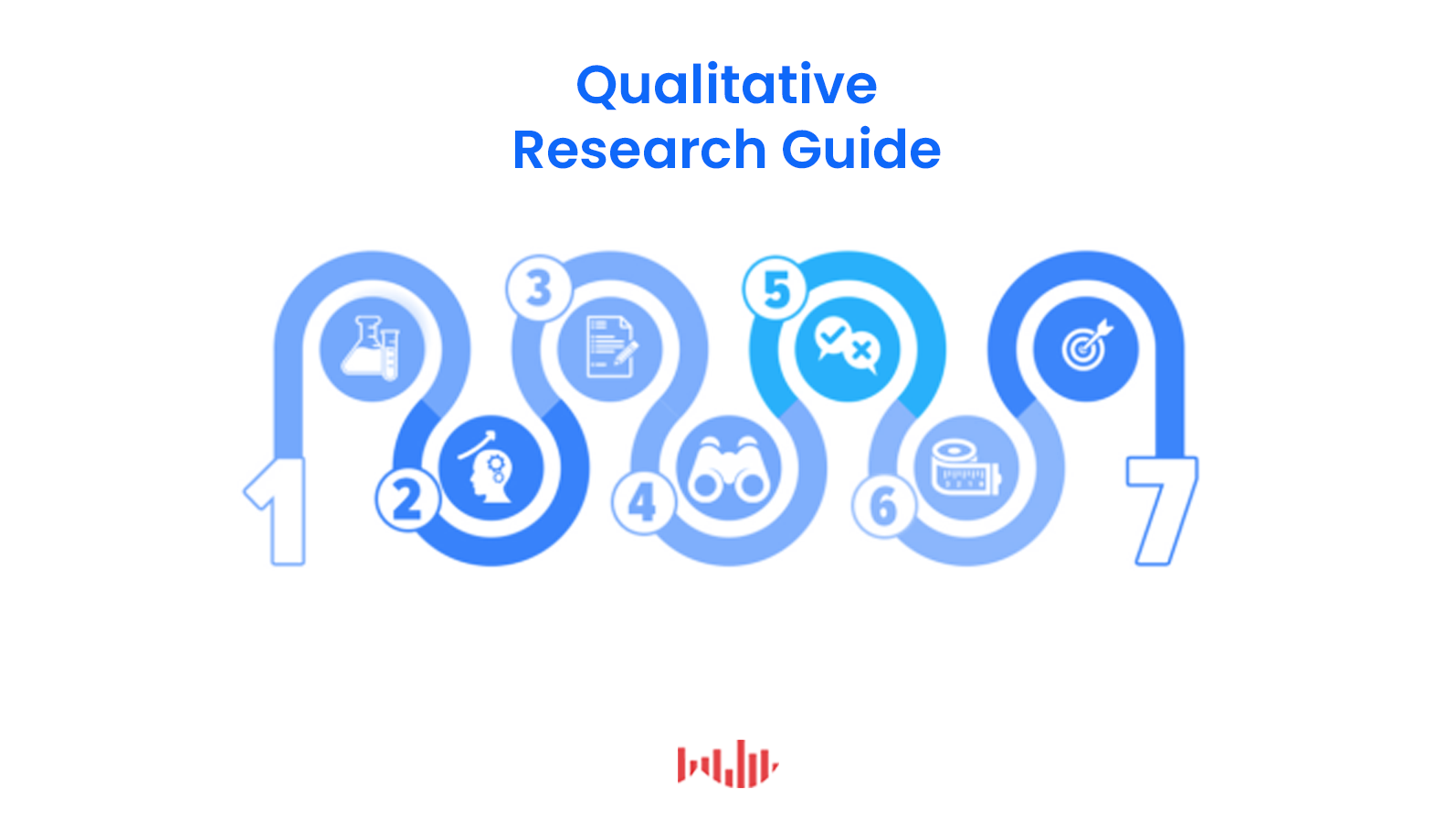 Qualitative research is one of the most prominent research methods in the ever-increasing research sphere. Running counter to quantitative research, qualitative research encompasses a distinct set of differentiating qualities (no pun intended). These attributes prove that these two methods ought not to be used interchangeably.
Qualitative research is one of the most prominent research methods in the ever-increasing research sphere. Running counter to quantitative research, qualitative research encompasses a distinct set of differentiating qualities (no pun intended). These attributes prove that these two methods ought not to be used interchangeably.
So what exactly is qualitative research? At a glance, this type of research method seeks to gather in-depth data about a phenomenon without focusing on numerical data or on quantities.
But there is much more to this kind of study method. Learn holistically about qualitative market research with this complete guide.
What Defines & Makes Up Qualitative Research?
Qualitative research is centered around experiences, ideas and opinions. As such, it does not focus on statistical or quantitative outcomes. Instead, it seeks out an in-depth understanding of an issue, occurrence or phenomenon.
Thus, this research method zeroes in on the “what” and more importantly, the “why” of a research subject. (Unlike quantitative research, which focuses on the “how much”).
Here are some of the applications of qualitative research:
Understanding an issue in greater depth
Finding the reason behind an occurrence (whether it’s desirable or undesirable)
Uncovering trends in target market opinions
Forming educated solutions to address customer/studied subject concerns
Discovering the causes of certain actions
Qualitative research generally relies on a smaller sample size in order to get a deep read of happenings, causes and motivations. This kind of research method functions through the usage of open-ended and exploratory questions.
Understanding the “why” behind an issue is then used to make decisions on how to resolve the issue or how to improve on an existing productive situation.
Qualitative data must occur in natural environments. This denotes a kind of environment in which participants discuss their opinions at length and at ease, which researchers use to gain deeper knowledge and form inferences around a topic.
Prior to the internet, this kind of research was conducted in-person, but with the advent of the internet and innovations in market research, qualitative data has been collected online. The digital space can also serve as a natural environment.
The Five Main Types of Qualitative Research
Just as with quantitative research, there is not a single approach to conducting qualitative research. On the contrary, there are five main varieties of performing qualitative research. Aside from their methodology, these sub-categories also seek different types of answers and conclusions.
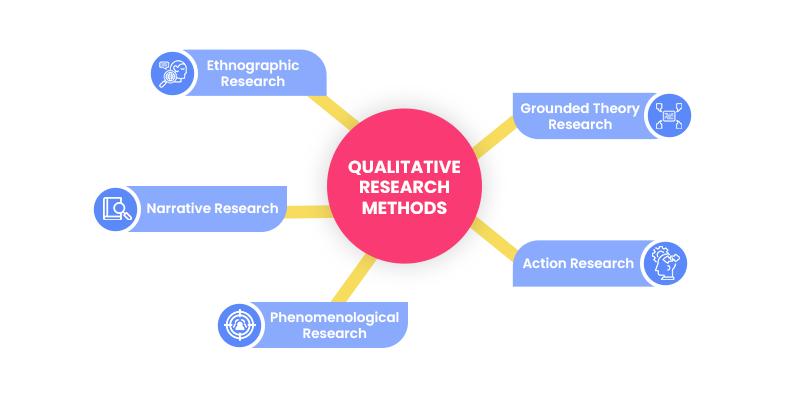
1. Narrative Research
This research is used to form a cohesive story, or narrative, by way of consolidating several events from a small group of people. It involves running in-depth interviews and reading up on documents featuring similar actions as a means of theme-searching.
The point of this is to discover how one narrative is shaped by larger contextual influences. Interviews should be conducted for weeks to months and sometimes even for years. The narrative that the researcher uncovers does not have to be presented in sequential order.
Instead, it should be projected as one with defined themes that attempt to reconcile inconsistent stories. This method can highlight the research study’s ongoing challenges and hardships, which can be used to make any improvements.
2. Ethnographic Research
The most common qualitative research method, ethnography relies on entrenching oneself in various participant environments to extract challenges, goals, themes and cultures.
As the name suggests, it involves taking an ethnographic approach to research, meaning that researchers would experience an environment themselves to draw research. Using this firsthand observation, the researcher would not need to then rely on interviews or surveys.
This approach may seem to be far-fetched where market research is concerned, but it is doable. For example, you’d like to see the effectiveness or frustration that customers face when using your product. Since you can’t follow them home, you can request videos that show them using it. Many big brands have call-outs on their websites (ex: on product pages) for their customers to send in videos of their interactions with the products.
3. Phenomenological Research
This qualitative method entails researchers having to probe a phenomenon or event by bringing lived experiences to light and then interpreting them. In order to achieve this, researchers use several methods in combination.
These include conducting surveys, interviews and utilizing secondary research such as available documents and videos on the studied phenomenon. Additionally, as in ethnographic research, phenomenological research involves visiting places to collect research.
These will help you understand how your participants view your subject of examination. In turn, you will gain insight into the participants’ motivations.
In this research type, you would conduct between 5 and 25 surveys or interviews, then peruse them for themes. Once again, you would scrutinize experiences and sentiment over numerical data.
4. Grounded Theory Research
In contrast to phenomenological research, which seeks to fully form the core of an issue, grounded theory attempts to find explanations (the why) behind an issue. To achieve this, researchers use interviews, surveys and secondary research to form a theory around the issue/occurrence.
The sample of this study tends to be on the larger side, at 20-60 participants. Data extracted from this type of research is interpreted to determine the reasoning behind, for example, heavy usage of or frustration with a product. These types of studies help a business innovate an existing product by getting into the weeds of how it’s used.
5. Action Research
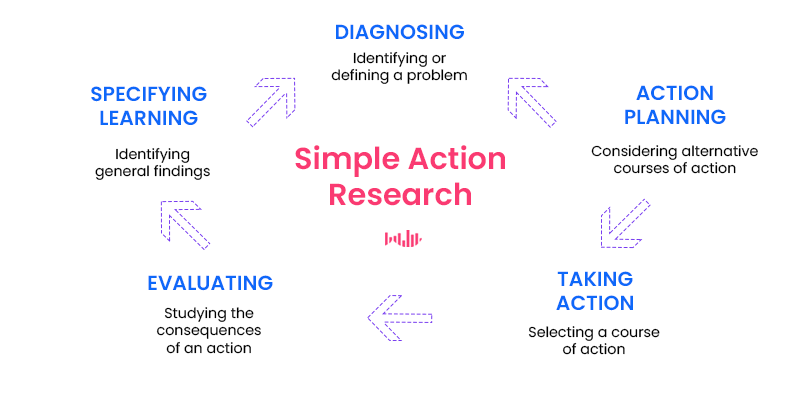
This type of research involves researchers and participants working collaboratively to bring theory to practice. Also called participatory research, collaborative inquiry, emancipatory research and action learning, this method entails the act of “learning by doing.”
This means a group of researchers come together to find and address a problem, resolve it and then study the success of their endeavors. If they underperformed or their outcomes don’t satisfy their expectations, they would then reattempt the process.
In action research, a researcher spends a considerable amount of time on collecting, analyzing, and presenting data in an ongoing, periodic process. This involves researchers coming up with their own surveys and interviews around a subject matter, then presenting their findings to one another to draw conclusions and solutions.
They would put into practice the means to improve a situation and continue measuring their success throughout the process.
Examples of Questions for Qualitative Research
When working within the capacity of any of the above research types, it’s crucial to ask the right questions. Here you’ll find the questions you can use when conducting each of the five types of qualitative research.
Bear in mind that some of these questions will appear to be similar in nature; some are even interchangeable. That is normal, as researchers may search for the same answers, but apply a different approach in their research method.
In any case, all of the below features questions that fit within the larger qualitative research framework.
Learn more about asking insightful market research questions. Here are a few examples of the questions within the five categories:
1. How do people who witnessed domestic violence understand its effects in their own relationships?
Variable: Views of domestic violence on one’s own relationships
Demographic: People in relationships, who’ve witnessed domestic violence
Qualitative Research Type: Narrative
2. What are the lived experiences of working-class Americans between the ages of 20 and 40?
Variable: Experiences and views of a working-class background
Demographic: Working-class Americans ages 20-40
Qualitative Research Type: Narrative
3. How do Asian Americans experience reaching out to address mental health concerns?
Variable: The experiences in seeking out care for mental health
Demographic: Asian Americans seeking help for mental health
Qualitative Research Type: Ethnographic
4. What do you enjoy about this product or service?
Variable: The positive experiences of using a particular product/service
Demographic: The target market of a product or service
Qualitative Research Type: Ethnographic
5. How have people who have experienced poverty changed their shopping habits when they entered the middle (or higher) class?
Variable: The changes or stagnation in shopping habits
Demographic: those who experienced poverty, but climbed the social ladder
Qualitative Research Type: Phenomenological
6. What was it like when you had a negative online shopping experience?
Variable: unpleasant shopping experiences
Demographic: a group that is most likely to shop at a particular online store
Qualitative Research Type: Phenomenological
7. What influences managers in private sectors to seek further professional advancement?
Variable: Motivation for seniority
Demographic: Managers in the private sector
Qualitative Research Type: Grounded Theory
8. How do women in third world countries set up financial independence?
Variable: Efforts at reaching financial independence
Demographic: Women in third-world countries
Qualitative Research Type: Grounded Theory
9. What impact does collaborative working have on the UX optimization efforts of a telecommunications company?
Variable: effects of collaboration on the UX of a telecommunications company
Demographic: workers in the telecommunications space
Qualitative Research Type: Action Research
10. What strategies can marketing managers use to improve the reach of millennial customers?
Variable: Strategies to improve millennial reach and their outcomes
Demographic: Marketing managers
Qualitative Research Type: Action Research
When to Use the Research and How to Analyze It
The qualitative research method has specific use cases. You ought to consider which is best for your particular business, which includes your strategy, your marketing and other facets.
The core of qualitative research is to understand a phenomenon (a problem, an inadequacy, and a slew of other occurrences) including its causes, its motivations, its goals and its solutions. Researchers do this by observing smaller portions of a population.
Researchers should use this form of research whenever you need to get the gist of a particular occurrence or event. It is particularly useful for studying how your target market experiences certain situations and how it feels about them.
There are several more specific ways that elucidate why this research style is valuable if not completely necessary. Here are some of the most crucial ways this method of research is vital:
Helps brands see the emotional connections customers have with them
Allows brands to find gaps in customer experience (CX) and user experience (UX)
Enables brands to create experiences that are more tailored to their target market
Helps businesses understand how they can improve on their product, service or CX
Finds experiences that customers had that highlight sensitive topics/language for them
Shows businesses how customers compare them to their competitors
Identifies possible solutions and innovations based on customer attitudes and experiences
To analyze qualitative research, you should first identify your subject of study and decide on the type of research you need to conduct based on the five types of research that fall under the qualitative category.
Then, brainstorm several questions that you can use to form the base of your studies. During the process make sure to jot down (either digitally or otherwise) your observations. For example, record interviews and store surveys in an organized database.
Make sure you ask open-ended questions in surveys, interviews, focus groups, et al. Aggregate secondary research such as government database documents, articles in your niche, images, videos and more.
Search for patterns or similarities within your findings. When you group them together and organize them by demographics, you can start drawing conclusions and proposing solutions.
The Benefits and Drawbacks of Qualitative Research
Qualitative research can be extraordinarily beneficial. But as with other aspects of research and beyond, it too comes with a set of drawbacks. As a business owner, marketer or market researcher, you should know both the pros and cons. Here are some notable ones:
Benefits
More intimate understanding of context and causation: besides understanding “what” in a granular way, you also learn the “why” and “how” of a particular situation.
Understanding key experiences: Open-ended questions lead to unique answers, exposing things numerical-based surveys can’t answer.
A foundation of deep insights: The design of the study is made to understand how customers relate to particular occurrences, events, ideas and products.
Context-driven: Finding insights on motivation and past behaviors allows researchers to understand what their target market needs and what it tries to avoid.
No need to find and create the correct measuring units: Open-ended questions don’t require a scale, a number range or any other measuring tools — one less thing to worry about.
Smaller sample size: Smaller sample sizes allow researchers to study responses more thoroughly to form more accurate hypotheses and conclusions.
Inspirational: The responses received can also help researchers form new studies.
Flexible and detail-oriented: Since questions aren’t based on scales and other units, you can ask more creative and in-depth questions. Questions focus on details and subtleties for robust insights.
Drawbacks
Relies on researcher experience: It relies on the researchers’ experience; not all are familiar with industry topics.
Not statistically representative: Only collects perspective-based research; does not provide statistical representation. Only comparisons, not measurements can be executed.
Difficult to make copies of data. Individual perspectives make it hard to replicate findings, making it it more difficult to form conclusions.
More likely to have researcher bias: Both conscious or subconscious of the researcher can affect the data. The conclusions they draw can thus be influenced by their bias. (This can be avoided by using controls in data collection.
The Final Word
Market research is a wide-spanning undertaking. It has a wide swath of aspects, practices and applications. As such, researchers should know its main categories and qualitative research is one such category of significance.
As opposed to quantitative research, which has four methods, qualitative research has five — not all of which will be of use to your particular market research needs. In any case, this type of research involves imbuing as much context and particularities around a phenomenon as possible.
As such, researchers should create questions more specific to the aforementioned examples of this article. That is because those are more encompassing, generalized questions that researchers can attempt to answer after conducting all of their research and parsing of the findings.
But prior to that, researchers should ask several related questions around a particular topic and tailor those questions as best as possible to the target audience.
Frequently asked questions
What is qualitative research?
Qualitative research is a type of research that is conducted to gain deep or unexpected insights rather than focusing on numeral or quantitative data.
Why is qualitative research conducted?
Qualitative research is conducted to find the “why” of the research subject, rather than the “what’ of that subject. For example, qualitative research might be conducted to understand an issue more deeply, to understand why something is happening, or to learn how to address a target market’s concerns.
What is narrative research?
Narrative research is a type of research that is used to create an in-depth story about a phenomenon or event. It is conducted by interviewing a small group of people who were directly involved in the event.
How is ethnographic research conducted?
When conducting ethnographic research, the researchers use firsthand observations of an environment to more deeply understand the goals, challenges, or opinions of the target audience.
What is action research?
Action research is a type of qualitative research in which researchers and participants collaborate to better understand a phenomenon. Together the group works to find and solve the problem by gathering information on an ongoing and evolving basis.

















